




he collapse of Gov. Kathy Hochul’s pro-growth housing agenda may have seemed like a blow to the real estate industry, which has long pushed for making it easier to build more in New York. But one landlord group celebrated the budget outcome in a message to members this month, saying their advocacy had
doomed the policy they feared most of all: “good cause” eviction.
“Consider this — housing issues, including e orts to pass reckless good cause eviction — being out of the budget is a consequence of your hard work in speaking up,” reads the newsletter by the Rent Stabilization Association, which represents 25,000 building owners in the city. “Your voice matters that much.”
e message captured a central dynamic of New York’s latest budget process: Although developers would have liked to see Hochul’s growth mandates pass, real estate groups focused much of their energy on opposing the measure that would cap annual rent increases and bar landlords from evicting tenants without pointing to a speci c,


But some real estate executives believe that the best way to revive the heart of business districts is by appealing to workers’ stomachs.
e key, they argue, are food halls, the kiosk-lined storefronts serving a United Nations of dishes in a casual setting often featuring distressed oors and trendy tunes.

TMET COUNCIL ON HOUSING INSIDE Urbanspace Vanderbilt at 230 Park Ave. See EVICTION on page 33
When anchoring the ground oor of an o ce building, a food hall can be a prized amenity, one that it’s hoped could give employees an extra push to return to their desks, advocates say.
And though the bet can seem counterintuitive from a business perspective—restaurants in general have been pummeled by in ation and the work-from-home routine—advocates say they actually are less risky than standalone eateries.

“It’s di cult [to] not see an even stronger case for food halls than what was present before the pandemic,” wrote Paul Colicchio, a food hall consultant and a director at Cushman and Wake eld, in a new

BY C. J. HUGHES
The city would need to set targets for housing growth in every neighborhood, especially places where construction has lagged, under a bill introduced May 11 by City Council Speaker Adrienne Adams.
e legislation, which is backed by a majority of the council, will require the city to set ve-year growth targets for each of its 59 community districts. But unlike the housing mandates pushed unsuccessfully by Gov. Kathy Hochul in recent weeks, it has no enforcement mechanism, meaning neighborhoods would not be held accountable for missing the not-yet-determined targets.
“While our city has grown in population and job opportunities, our rate of housing production has not kept up,” Adams said at a news conference outside City Hall, anked by dozens of council members and representatives of labor unions and pro-housing groups.
Adams’ legislation builds o the “Fair Housing Framework” that she rst previewed in December 2022. In addition to the growth targets— which would be set by the departments of Housing Preservation and Development and City Planning—it would require those agencies to draw up a fair housing plan every ve years starting in 2025 with ideas for getting low-producing neighborhoods to

build more a ordable units.
“Workers can’t secure jobs and New Yorkers cannot remain in the city they love, and their communities, if there is not enough available housing,” Adams said.
But Vicki Been, a former deputy mayor for housing under Bill de Blasio who now leads New York University’s Furman Center, said she worried that the lack of enforcement would give the council’s bill little weight, and that setting di erent targets for each community district would only leave room for neighborhoods to challenge the policy.
“I don’t understand what we’re going to accomplish by having a complex, precise allocation per community district with no consequence,” said Been, adding that she applauds the council’s attention to the problem.
Enforcement
Adams mostly de ected questions about the bill’s lack of teeth, saying she did not want to set construction targets “with a punitive lens.” Andrew Fine, policy director of the pro-housing group Open New York, said the City Council lacks the ability to impose construction mandates through regular legislation—instead, it would need to come through a citywide zoning text amendment, a charter revision to grant the council that power or, more easily, through a state law.
CRAIN’S AWARDS EVENTe council speaker and council leadership did not take a position on Hochul’s housing compact, which would have set 3%-everythree-years growth mandates in towns and cities statewide—and at the neighborhood level within the city—but collapsed amid opposition in the suburbs and some pushback in the ve boroughs.
Asked why she did not get behind the governor’s reforms, Adams said that “the state and the city work differently,” and that the council was acting on its own timeline separate from the state’s budget process.
e council’s idea of varying growth targets per district may be “fraught with danger,” Been added.
ough based on the reasonable claim that every neighborhood is di erent, such complexity could prove much less e ective at spurring production than an across-the-

board mandate.
“With complexity comes both delays and litigation, and opportunities for well-resourced neighborhoods to get a number that they prefer,” Been said. “I’d rather establish the principle: ‘Every neighborhood has to step up.’”
Moreover, Been noted, other aspects of the plan seem to overlap with initiatives that are already on the books. A demand that the city produce data on “fair housing and equity” has much in common with the de Blasio-era Where We Live NYC Plan, which last year produced a website complete with data on housing affordability, construction rates and socioeconomic conditions—broken down by community district.
And a long-running program by the federal Department of Housing and Urban Development already requires New York to submit reports every ve years that detail fair housing problems and strategies for improving them.
“A lot of what they’re asking for is required by HUD, so [the council] should just read what the city gives to HUD and not require duplicative and perhaps inconsistent things,” Been said.
While Adams’ bill could name and shame neighborhoods that build the least, it is already public knowledge which parts of the city have seen the slowest housing growth. A 2020 Citizens Budget Commission report
identi ed low-rise outer-borough areas such as Bensonhurst, Maspeth and Kew Gardens as having approved the fewest housing units per 1,000 residents since 2010; Hell’s Kitchen, Downtown Brooklyn and Long Island City built the most in that period.
“ e framework will help the city ensure well-resourced neighborhoods that have not equitably contributed to a ordable housing production do their fair share,” Adams said.

It is also unclear how wellequipped the City Planning and Housing Preservation and Development departments, already shortsta ed like other city agencies, would be to handle new tasks assigned to them by the council. Both agencies referred requests for comment to City Hall spokesperson Charles Lutvak, who said the mayor’s o ce “appreciates the speaker’s “partnership in advancing this critical work.”
Rachel Fee, executive director of the New York Housing Conference, praised the council’s plan, saying it could bolster Mayor Eric Adams’ forthcoming zoning text amendment on housing, which notably lacks any growth targets for speci c neighborhoods.
Fine, of Open New York, called Adams’ legislation “a great rst step,” but one that should be paired with state legislation to have a real impact. ■
Mark your calendar to hear from Janno Lieber, chair and CEO, MTA, interviewed live on stage by Crain’s New York Business Editor-in-Chief Cory Schouten. Find out how the MTA plans to address its budget de cit, where things stand on congestion pricing, and how the agency is testing service changes to match evolving traf c patterns driven by hybrid work.
Time: 8:30 – 10:00 a.m.
Location: 180 Central Park S. www.crainsnewyork.com/pb_lieber
More than 300 women from across the city’s business and civic community gathered May 10 at Gotham Hall in Midtown to celebrate the nalists and winners of Crain’s rst Women of In uence Awards.

THE HONOREES ECHOED THE HARD WORK IT TOOK TO RISE IN MALE-DOMINATED INDUSTRIES
e awards highlight the in uence of women in their respective elds, rather than just ranking them by most powerful, said Fred Gabriel, Crain’s publisher and executive editor. e nalists include a mix of peer nominations and newsroom selections, allowing the members of the business community to weigh in on who’s been the most in uential to them.
Among the honorees on hand to accept their awards: state Attorney General Letitia James; Keechant Sewell, commissioner of the city Police Department; Jessica Tisch, commissioner of the city Department of Sanitation; Community Board 5’s Layla Law-Gisko; Yesenia Scheker Izquierdo, managing partner for KPMG’s New York o ce and market hub leader; and Nancy Hagans, president of the state Nurses Association.
Winners were selected in three peer-nominated categories. e award for “mentors” went to Marianne Monte, chief people and administration o cer at Shawmut Design and Construction.
e award for “rising stars” went to Carey Shu man, executive director and head of the women’s segment at UBS. e City Council, the Women Builders Council and the Levinson Group were honored as the top women-focused workplaces.
As they accepted their awards, the honorees echoed the hard work it took to rise in male-dominated industries.
“I made the decision to separate from a job I loved and a police family I adored to challenge complacency to a ght in the largest polic-
ing arena in the world, with a glass ceiling rmly intact,” Sewell said. James credited her tenacity to take on big cases—such as the prosecution of former President Donald Trump—to coming from a long line of women who refused to accept the word “no.” ■
The upstart: Werewool
The fashion industry is among the most polluting in the world. It contributes as much as 8% of the globe’s carbon emissions, according the United Nations Environment Programme, and 85% of all textiles hit the dump each year, according to the U.N. Framework Convention on Climate Change.
How to x this?

Enter Werewool, a biotech startup that says its new biodegradable bers could revolutionize the industry.
e 10-person company, which is based in a Prospect Le erts Gardens lab and just received $3.7 million in seed funding, says it takes its inspiration—and blueprints—from nature.
It is making bers, for instance, produced from a modi ed form of the DNA found in red coral. e DNA tells bacteria to produce a “designer protein” that can be extruded into a ber that is naturally uorescent red, co-founder and CEO Chui-Lian Lee says. No need for toxic dyes to produce the vivid color—the hue is built in.
gradable bers based on Werewool’s technology, he says.
The reigning Goliath: DuPont
e Wilmington, Delaware-based multinational chemical company, founded in 1802, operates in many industries, including bers and fabrics, and it is developing its own eco-friendly bers. DuPont, which employs more than 23,000 people, reported net sales of $22 billion in 2022.
How to slay the giant Co-founders Chui-Lian Lee, 34 and Valentina Gomez, 25, met in 2018 while studying textile development at the Fashion Institute of Technology. ey discovered a mutual passion for sustainable fashion. While neither had a science background, they teamed up to enter an “animal-free wool” bio design contest. eir idea to invent a new kind of wool based on human DNA (hence the name “Werewool”) led them to a self-taught bio hacker in Long Island City, who encouraged their e orts.
ANNE KADET
Werewool says it will use a similar process to create biodegradable bers that are naturally stretchy, waterproof or have anti-microbial properties to prevent post-exercise stink.
“ e technology they have developed is unique and opens the door to a lot of nice-performing products,” says Michael Krel, a partner with the Industrial Biotech Strategy arm of venture capital giant So nnova Partners, which invested in the company’s seed round.
It’s still early days for Werewool. e startup hopes to produce its rst item of clothing—a pink shirt—in about 18 months. It may take years before it turns a pro t licensing its technology to ber manufacturers.
But the potential market is huge, Krel says. Any clothing that employs non-biodegradable bers such as Spandex or harmful dyes and toxic nishes could someday be made with biode-
“He had a laboratory in his extra bedroom in his parents house, and also in his kitchen, and we would work there,” Lee says.
In 2019 they landed a small grant and teamed up with a third co-founder, eanne Schiros, an FIT professor and Columbia University research scientist who is the company’s chief science o cer. Schiros introduced them to additional Columbia researchers, Helen Lu and Allie Obermeyer, who invited them to use the university’s labs. ey also joined the startup as co-founders.
Werewool pegs its o cial launch to April 2020, when it won a Global Change Award grant worth about $275,000 from the H&M Foundation. e founders also hired a dedicated researcher to continue developing their bers. is, along with additional grants, kept them going through 2022.
e founders needed more substantial backing, but their initial fundraising e orts met resistance. “We heard more
than 100 noes,” Gomez says.
ey soon realized they weren’t asking for enough money; $500,000, the company’s original funding pitch to investors, doesn’t go far in biotech, and the small ask didn’t look realistic. ey landed investors after developing and pitching a more substantial, long-term business plan requiring more capital.
On the advice of a mentor, they decided to develop bers that combine their own lab-created designer proteins with cheaper plant-based proteins. is will help reduce the cost for a kilogram of yarn from $80 to $8 to $15—on par with the cost of standard materials.

Another challenge: hiring researchers on a shoestring budget. e founders had more recruiting success when they focused on the “inspired by nature” story rather than a hardcore science narrative about proteins and enzymes.
“You have to nd people who really like what you do, who really share your passion,” Gomez says.
It is the founders’ passion for sustainable fashion, combined with their patented technology, that will take this company far, says Corinna Chen, a partner with Material Impact, a venture capital rm that co-led the seed round in Werewool with So nnova Partners.
“I have seen Ph.D.s try to work with big fashion houses, but often they speak very di erent languages,” she says. “Werewool’s technology has origins in science and fashion, meaning they are creating products that are highly innovative while also resonating with major fashion brands and consumers.”
It’s one thing to have trained scientists producing newfangled bers in a lab—Werewool must develop materials that can be produced in large volumes and withstand a standard manufacturing environment, Chen says, adding: “ at takes time, iterations and capital.” ■
Turtle Bay condo, listed at $10M in 2018 and at $7M now, hasn’t found a taker for years
BY C. J. HUGHESDays after the coronation of King Charles III, New York may soon see its own English-themed changing of the guard.
A 5,800-square-foot penthouse apartment that once housed the city’s British consulate general and that’s owned by the British government is to be sold through an auction after failing for years to find a buyer through conventional means.

On May 22, buyers will have the chance to bid for No. PH1 at 351 E. 51st St., a four-bedroom condo on First Avenue, near the United Nations in Turtle Bay. Interested parties need to fork over $75,000 to be able to compete for the property,
$2.0M
STARTING BID for No. PH1 at 351 E. 51st St.
the home could trade well below even that.
“The seller said, ‘Let’s auction it. Let’s get whatever the market value is, and let’s move on,’ ” said Scott Kirk, Interluxe’s president and chief executive officer. “This is an owner who understands the value of time and money.”
The full-floor unit, with seven baths, a 1,200-square-foot wraparound terrace and four exposures, also has a more than 100-foot-long main living space, which has reportedly been the site of lavish parties since the British government purchased the condo in 2002.
and bids start at $2 million. Winning buyers will have 24 hours to pay a 10% deposit, according to Interluxe, the company handling the auction, which is its first for a New York residence.

Buyers must pay a 12% premium on top of the sale price, money that helps pay the fees for the auctioneer and the brokerage Brown Harris Stevens, which had been marketing the property.
But even if the apartment trades for several million dollars above its starting price, it would still be considered a major loss. It came out of the gate with an asking price of $10 million in 2018, but the place found no takers for years, even after dropping its price to $7 million in the summer of 2022. It’s now possible
The sale price back then is not clear from the transaction documents. But the papers do reveal the official name of the buyer, which may be among the longest (and most formal) to ever appear on a deed: the Secretary of State for Foreign and Commonwealth Affairs of Her Britannic Majesty’s Government of the United Kingdom of Great Britain and Northern Ireland.
British consulates, which are smaller than embassies, were established to help British citizens with issues that may arise while they’re traveling or working abroad. They are in eight U.S. cities, including San Francisco, Miami and Atlanta.
New York’s consulate general is Emma Wade-Smith, who was appointed in 2021 and works out of an
office on Second Avenue at East 48th Street. It was unclear if WadeSmith had been living at 351 E. 51st St. or where she might go next.
 BY EDDIE SMALL
BY EDDIE SMALL
Abuilding in Kips Bay that is more than a century old won’t be around much longer.
Empire Management recently filed plans with the Department of Buildings to demolish 200 E. 26th St., a 5-story, 45-unit residential building. The estimated job cost is $800,000, and the current building spans about 37,000 square feet, the filing says.
The real estate firm, run by CEO and founder Fred Ohebshalom, purchased the site in 2007 for about $19.3 million, property records show. Empire Management has several other residential properties
in the city, including buildings at 210 W. 10th St., 261 W. 21st St. and 284 Fifth Ave., along with multiple commercial properties in Midtown South, according to the company’s website.
Empire Management did not respond to a request for comment about its plans for the site.
The Kips Bay building, also addressed as 351 Third Ave., does not have any active listings, although a studio apartment rented as recently as February for $3,000 a month, according to StreetEasy. Rents for apartments in the past year ranged from $2,800 for a studio to $4,250 for a two-bedroom.
The New York Times featured the building in a 2011 edition of its former real estate column The Appraisal, noting that the property’s lobby was once home to “nostalgic, pastoral murals” that a former tenant had painted but was undergoing a renovation that would paint them over.
The property was built in 1920 and contains 29 two-bedroom apartments, 14 studios and two one-bedrooms at an average size of 824 square feet, according to CoStar.

The city’s Fire Department and Department of Buildings recently sued Empire Management, accusing the firm of failing to fix hundreds of violations in eight Upper Manhattan apartment buildings. ■
A message sent to Britain’s foreign office was not returned by press time. Christopher Kromer, the Brown Harris Stevens
“THIS IS AN OWNER WHO UNDERSTANDS THE VALUE OF TIME AND MONEY”351 E. 51ST ST., NO. PH1, a 5,800-square-foot penthouse apartment with four bedrooms and terrace in Turtle Bay.
At NewYork-Presbyterian, data scientists and doctors from Columbia and Weill Cornell Medicine are ushering in a new era of health care. They’re combining their vast experience caring for diverse communities and pairing it with the latest in predictive analytics. Which means one day we can help you get ahead of a health issue before it becomes one—to stay amazing today and tomorrow.

The stock market has been flat since February, but regional banks were down 40% heading into May 5. That’s a legitimate shock to the economy. Three formidable parties are to blame for this unfortunate situation: the Federal Reserve, remote workers and aggressive bears.
But first, the numbers: Half of all bank stocks were trading below tangible book value heading into May 5, according to analysts at Janney Montgomery Scott. That is bad, although not Lehman Brothers-era kind of bad.
Back then 62% of banks traded below book. It means whatever the market is afraid of, the fear isn’t as extreme as during the worst
ing down financially in 2008, Chief Executive Officer Jeff Immelt likened the ordeal to facing a relentless force that would attack and regroup, then attack again. “That’s what the financial crisis was,” Immelt said in William Cohan’s delectable book about GE, Power Failure.
Attacks against banks come from Wall Street bears who are selling their shares short and have made $7 billion in profits in recent weeks, according to S3 Partners. Rumor is the government will temporarily ban the short-sale of bank stocks.

The last time that happened was in 2008.
economic crisis since the Great Depression. I guess that’s good news.
Now about the bears.
When General Electric was melt-

If it doesn’t, the bears figure to attack again soon because the Fed hasn’t ruled out further interest rate increases to squeeze out inflation. Higher rates squeeze profit margins at small and midsize banks, which are under pressure to substantially raise the rates they pay to depositors so they won’t yank out their money. Bankers hope the government will soon raise the Federal Deposit Inusrance Corp. insurance
cap to $1 million or even more, so uninsured deposits don’t depart.
“You can’t have banks that are too big to fail and banks that are too small to succeed,” said Ira Robbins, CEO of Valley Bank, a New Jersey-based small-business lender with $60 billion in assets.

Tethered portfolio
Banks like Valley are tethered to commercial real estate–it’s 60% of the loan portfolio in some cases. With remote workers remaining productive from home, office buildings figure to remain dead money for years.
The problems at small banks are fertile ground for activists such as Carl Icahn, who would really love to be in the news for a different reason. At any time he or one of his type could snap up a big stake in any number of stressed banks and howl for mergers. Fund managers made big money this way coming out of the savings-and-loan crisis 30 years ago, so perhaps we’re on the cusp of a second golden age of shotgun bank marriages.
But at least for now, the Icahns of the world are nowhere in sight because things could get worse for banks before they get better. The
CEO of office landlord Vornado Realty Trust, which has $10 billion in debt obligations, said this week that it’s too early to call a bottom in office on a call in which an analyst asked whether the company’s move to buy back $200 million in stock was “akin to catching a falling knife.”
A funny thing about business journalism is there are lots of stories about contrarian traders making smart calls, but no stories ever about knife-catchers. That’s because contrarian calls rarely work. They are contrarian, after all.
In October 2001 a sharp young Wall Streeter bought a lot of Enron’s fast-falling stock and asked a friend what he thought. The friend, DataTrek Research co-founder Nick Colas, consulted a veteran trader who said to never, ever buy a stock hitting a new low. Enron went to zero and the sharp young Wall Streeter was gone. It doesn’t always work out that way, but buying or holding a falling stock is a solid way to lose a lot of money.
“Markets as a whole know this,” Colas said, “which is why U.S. regional bank stocks have no friends just now.” ■
Adam Sullivan is no more. Even for those who pay close attention to New York politics, the prior sentence would’ve been meaningless before this year. Sullivan was a complete unknown, operating in the shadows, yet he functioned as one of the most influential men in New York. He was Gov. Kathy Hochul’s prized adviser and now, after tough reporting from The New York Times, he has been forced to resign.
Sullivan was never a state employee and never had a formalized title in Hochul’s orbit. He was paid to oversee her 2022 campaign and offered advice on a variety of matters. He served as the liaison between Hochul and the state Democratic Party, which has been barely functional for years. More crucially, he was the voice Hochul listened to most, and he was closely involved in her most disastrous political decisions.
He was the adviser who oversaw the process of selecting a lieutenant governor who was on the cusp of an indictment.
He was the adviser who told Hochul to ignore concerns about crime bubbling up last year, even as
her Republican challenger, Lee Zeldin, rapidly closed a large polling gap.
He was the adviser who guided Hochul through her failed attempt to get Hector LaSalle confirmed as chief judge to the state’s highest court.
Sullivan was ousted before reports surfaced of past sexual harassment allegations against him that he did not deny. Female staffers on Hochul’s campaign were never comfortable with him, and many in Hochul’s world resented his influence.
What made it all the stranger was that Sullivan worked remotely out of Colorado, where he lives, and seemed to be an operative that subsisted solely from his relationship with Hochul. He managed her winning campaign for Congress in 2011, and they remained close after that, even as he ranged across the country to work on other campaigns. In 2014 he was fired as Mary Landrieu, the Democratic U.S. senator from Louisiana, was losing her re-election bid.
Every governor has a fixer, some of them ethically dubious. Andrew Cuomo’s right-hand man, Joe
Percoco, ended up in prison on corruption charges. But for all of Percoco’s volatility and corruption, those in Albany understood who he was and what he did. He had an office. Few, meanwhile, had ever seen Sullivan in the flesh. (In February I myself was surprised to learn of his existence.)
Looking forward
What will Hochul’s administration look like now? Will Sullivan’s departure lead to fewer obvious stumbles? Since the start of the
year, it’s been a curious first full term for Hochul, who replaced Cuomo after he resigned following a bevy of sexual harassment and assault allegations. She has yet to truly find her footing, failing to persuade the Legislature to support her ambitious plan to build more housing in the suburbs while securing further tweaks to the state’s bail laws, infuriating progressives while failing to placate her conservative critics.
Both Cuomo and David Paterson, Cuomo’s predecessor, recently
converged on a podcast to argue that Hochul has yet to properly exercise her power as an executive. For all the flaws of the two men— Paterson’s tenure was scandalscarred and lasted less than three years—they aren’t entirely wrong. Hochul, at times, has seemed adrift. Perhaps later in the spring or during the summer that will begin to change.
● Can the state Legislature and Hochul come together in the last two months of the legislative session and reach any kind of agreement around housing? The budget was an utter failure on that front, and there’s little reason to be optimistic now. But a compromise of some sort—perhaps around stronger tenant protections and the revival of 421-a—is still plausible.
● New York lost out on the Democratic convention to Chicago, making Eric Adams the second mayor in a row to whiff on bringing a national convention here. It’ll soon be two decades since the chaotic 2004 GOP convention in the city, which was wracked by anti-war demonstrations and episodes of police brutality. ■
Ross Barkan is a journalist and author in New York City.

ROSS BARKAN
AARON ELSTEIN
“YOU CAN’T HAVE BANKS THAT ARE TOO BIG TO FAIL AND BANKS THAT ARE TOO SMALL TO SUCCEED”OREO QUEEN/FLICKR CENTER FOR THE PERFORMING ARTS Empire State Plaza, Albany.
New York City Department of Health and Mental Hygiene
As Deepa Avula completed her education, she realized her interest in data could be used to improve public healthfocused programs. She has worked for the federal government as well as the Division of Mental Health, Developmental Disabilities and Substance Use Services at the North Carolina Department of Health and Human Services. Her experiences drew her back to her native New York at a time when the city is at an in ection point for mental health care. Now, as the executive deputy commissioner of mental hygiene for the city’s Health Department, a role she assumed in March, she looks to implement Mayor Eric Adams’ mental health plan and make the role of communication in preparing for the next public health emergency more ef cient.
What do you see as New York’s biggest opportunities to increase ef ciency when it comes to providing mental health care?
Ef ciency looks like you’re leveraging resources to the greatest extent possible. So we know that we have a variety of different funding streams from the federal level, state level, the city level. [It’s] being sure to ensure that all of those funds complement each other and that we’re taking the best advantage of those funds to maximize care and support for those in need.
What are the biggest challenges to that process and to your role in general?
One of the good things about this moment is that there is a heightened awareness and focus on the issue of addressing mental health. But the reason
WHO SHE IS Executive deputy commissioner of mental hygiene, New York City Department of Health and Mental Hygiene
GREW UP Westerleigh, Staten Island
RESIDES NOW Westerleigh, Staten Island
EDUCATION Bachelor’s in criminal justice, George Washington University; master’s in public health, University of North Carolina at Chapel Hill
FAMILY TIME Now that she’s back in New York, Avula’s hobby is spending time with her niece and nephew, who live right next door.
PROUD MOMENT Avula said her proudest moment recently came from leading Maryland’s Substance Use and Mental Health Services Administration during the pandemic, making sure behavioral health providers could access funding and exibility.
[behind] heightened awareness is because the need and demand for services is really quite expansive right now. Also, we know that we have a very stretched and strained workforce. So being able to deliver the best possible care with the need being so great is challenging and also, as I mentioned, maximizing different funding streams and administrative opportunities. It’s
always a challenge to be able to do that, but it’s certainly also something that’s doable.
What should the city prioritize over the next year in order to accomplish its goals?
The great news for me and starting the role is that the city has really identi ed its commitment to very vulnerable populations in the mental health plan, and those populations aligned very well with what I would identify as key populations, that being individuals with serious mental illness, youth and families, and individuals at risk for overdose.
Speaking of the mayor’s mental health plan, what are your strategies for implementing it? [The plan] lays out a nice foundation and vision for the things that we want to achieve. One of the main strategies is making sure that we’re building key partnerships and relying on existing partnerships. Also making sure that we are bringing in funding [and] local and federal relationships as well. The other thing is ensuring that we are listening to members of the community, both providers as well as individuals who are recipients of our services and their families. Having a personcentered approach to any of this is critically important. And in order to execute, you have to take into account the voice of those that are going to be the ultimate bene ciaries of these efforts. What services should get more nancial attention?
When we look at the mayor’s commitment, we see things like the Clubhouse model being expanded and really focusing on not just the medical part of providing services to individuals with serious mental illness but making sure they have a place to live and thrive in the community. And then, also, a focus on some of our youth work is going to be critically important as we move forward in the city.
What is your strategy on effective communication by the Health Department?
My general strategy is to communicate as often as possible to engage others. Not only [is it] our role to tell you what we’re doing, but also to hear from you [about] what you need in the community. ■
 BY C.J. HUGHES
BY C.J. HUGHES
The mysterious buyer of the Flatiron Building, which promised to fork over $190 million to purchase the muchloved landmark but has so far not kicked in a dime, will face its jilted sellers in court.
Abraham Trust and its managing partner have been sued by some owners of the wedge-shaped tower for perpetuating a “fraud” to provide the small Virginia company with “15 minutes of fame,” according to a complaint led Friday in Manhattan’s Supreme Court.
e company, which is led by low-pro le investor Jacob Garlick, outbid the owners in a courtordered auction in late March. But Garlick never paid the necessary $19 million deposit within two days as stipulated, the complaint says, which killed the deal.
e plainti s, which include Je Gural’s GFP Real Estate, are seeking the promised $19 million, plus damages and fees for the botched purchase.
“Defendants’ failure to pay the
down payment and move forward with the purchase of the Flatiron Building was contrary to the multiple representations they made by participating in the auction,” the suit says, adding that Garlick’s maneuvers were a “fraudulent bid.”
Neither Garlick nor his company, Abraham Trust, had led a legal response to the accusations as of Monday afternoon. And a message left at Abraham’s o ce in Reston, Virginia, was not returned by press time. Also, Alan Fleishmann, a Washington, D.C.-based adviser retained by Garlick in the aftermath of the auction, did not respond to a request for comment.
For the past couple of years, the GFP-aligned group of owners has been battling another investor in the o ce building, Nathan Silverstein, over how exactly to renovate the empty structure. Earlier this year a Supreme Court judge ordered that the Flatiron Building be sold at auction to simplify its complicated ownership structure and help resolve the dispute about the future of the building, which is at Broadway and East 23rd Street.
Garlick, who did not previously own a stake, swept in with a $190 million bid, which inched out the o er of $189.5 million from the GFP-aligned group.
But because the rst deal went kaput, the court-appointed referee in the case had to order a second auction, which will take place inside the portico of the New York County Courthouse on May 23.
In intriguing new details about an opaque chain of events, the new case reveals that Garlick and his team were insistent for weeks after the March 22 auction in Lower Manhattan that they were not bootstrapped amateurs with no way forward but serious players with access to major capital, according to court papers.
Indeed on April 10, in an attempt to win an extension of the down-payment deadline, one of Garlick’s attorneys gave the referee a statement from a Chicago bank showing an account with a balance of around $12 million. But the name of the account’s holder was
redacted, the suit says.
Garlick’s team also provided the referee with a list of properties in Aspen, Colorado, supposedly worth $50 million, and other real estate in Napa, California, apparently worth $75 million. But again, the owners’ names were omitted.
As it was maneuvering behind the scenes, Abraham Trust was also investing in marketing. Its once bare-bones website is now full of information about the company and its principals, many of whom have been enigmas till now.
According to the site, Garlick, the rm’s managing partner, has advised about or helped syndicate $30 billion worth of transactions since founding Abraham in 2014. Previously, Garlick was a partner at MHelpDesk, a live-chat service that was ultimately acquired by HomeAdvisor, an IAC company.
Abraham’s chief nancial o cer, meanwhile, is Ransom Jones, whose past employers include Goldman Sachs, Citi and AIG, according to the site. And Abraham’s portfolio manager is Michael Peterson, a former director of a
non-alcoholic beverage company.
Completed in 1902 across from Madison Square Park, the terracotta Flatiron Building is today owned collectively by ve parties. Four of them, including GFP, together control a 75% interest. e other 25% is held by Silverstein, who inherited a stake his family acquired around World War II.
Friday’s suit also points out that Garlick is a relative of Silverstein, though Silverstein has told Crain’s that he had never spoken with Garlick until just before the auction. In the same interview, Silverstein also denied accusations that he and Garlick are in cahoots to elevate the price of the building to bene t Silverstein’s share.
e new suit will not a ect the May 23 auction, said attorney Peter Axelrod, the referee. But the ground rules will be stricter the next time around.
Bidders will have to come with a check for $100,000 made out to the referee. Bidders will also have to provide documents showing they have the money to close on the sale. ■

Government doesn’t typically rely on gentle suggestions to regulate businesses or individuals. It’s the threat of nes or other consequences that give its rules teeth.
So it’s disappointing that the City Council’s latest housing proposal—to create ve-year housing growth targets for 59 community districts—comes with no accountability or enforcement mechanism.
e light-touch approach on housing policy mocks the seriousness of our housing shortage and a ordability crisis and follows the lead of a state Legislature that punted on Gov. Kathy Hochul’s proposal to mandate every community step
New Yorkers cannot remain in the city they love, and their communities, if there is not enough available housing,” said Council Speaker Adrienne Adams in announcing the plan, which is backed by a majority of the council. “ e framework will help the city ensure well-resourced neighborhoods that have not equitably contributed to a ordable housing production do their fair share.”

up its housing production, delivering a state budget that does nothing on housing. Hochul’s plan collapsed amid opposition in the suburbs and some pushback in the ve boroughs.
“Workers can’t secure jobs, and
OP-ED
Adams mostly de ected questions about the bill’s lack of teeth, saying she did not want to set construction targets “with a punitive lens.” Andrew Fine, policy director of the pro-housing group Open New York, told reporter Nick Garber that the City Council lacks the ability to impose construction mandates through regular legislation. Instead, it would need to come through a citywide zoning text amendment, a charter revision to grant the council that power, or through a state law.
e council speaker and council leadership declined to take a position on Hochul’s housing compact, which would have set 3% growth mandates every three years for towns and cities state-
wide. e city’s target numbers would be set by the departments of Housing Preservation and Development and City Planning, which also would be tasked with drawing up a fair housing plan every ve years starting in 2025. Naming and shaming neighborhoods coming up short on housing may have some theoretical value. But it’s already clear which parts of the city have seen the slowest housing growth: A 2020 Citizens Budget Commission report identi ed low-rise outer-borough areas such as Bensonhurst, Maspeth and Kew Gardens
as having approved the fewest housing units per 1,000 residents since 2010. Hell’s Kitchen, Downtown Brooklyn and Long Island City built the most.
e council missed an opportunity to put muscle behind its targets by staying silent on the governor’s housing plan. With little chance of statewide action for the next year, the council should take other steps to make its targets enforceable, such as tacking its targets onto the upcoming housing text amendment pursued by Mayor Eric Adams. ■
Everyone is talking about making New York housing more a ordable and plentiful. But there are lessons from a unique “home-centric” culture that shouldn’t be overlooked.
As an Iceland-born architect who has been designing housing in New York for more than 30 years, I’ve seen the achievements and failures of our system—and I’ve seen solutions from the Scandinavian countries that can work here.
e Nordic countries—Denmark, Sweden, Norway, Finland and Iceland—have always been centered on home. eir culture has a concept called “hygge” (Danish) or “hugg” (Icelandic-old Norse) that captures the ideal of a Nordic home: warm, welcoming and comfortable, a place where you are safe and your heart lives. e tradition underpins the priority these countries give to quality housing.
Emerging from the great eco-

nomic hardships of the 1930s, these countries developed policies whose foundation mandated that government and institutions protect and promote economic and social well-being. ese egalitarian models created a safety net for the lowest-income citizens, particularly through public and social housing, facilitating a more integrated and true middle class.
Five examples:
● Almost 20% of Swedes live in “public housing,” which is open to any income level and essentially means affordable housing run by local municipalities. It is integrated into the city to the same standards as private development, with the joint mandate of affordable rent and fiscal responsibility, so that the housing is maintained for the long term. This public housing is very different from ours, a clear reminder of the investment and community connection that are often lacking
in New York.
● For more than several decades, Finland has been a world leader in steadily reducing its homeless population by providing permanent supportive housing. In doing so, vulnerable people are stabilized faster, placed back into employment, and integrated into society with better results than our shelter system, and at lower long-term cost.
● In Norway, which has a homeownership rate of 80%, a large proportion of homes are cooperatives managed by cooperative housing associations, designed to help people get a foothold on the economic ladder and participate in creating wealth through homeownership.
Co-ops have long been a staple of New York housing, and we should start building more of them in our pursuit of an equitable city.
● Denmark is creating an award-winning mixed-income housing design that enhances its cities. Government-sponsored competitions create inspired community
president & ceo K.C. Crain
group publisher Jim Kirk
publisher/executive editor
Frederick P. Gabriel Jr.
EDITORIAL
editor-in-chief Cory Schouten, cory.schouten@crainsnewyork.com
managing editor Telisha Bryan
assistant managing editors Anne Michaud, Amanda Glodowski
director of audience and engagement
Elizabeth Couch
audience engagement editor Jennifer Samuels
digital editor Taylor Nakagawa
art director Carolyn McClain
photographer Buck Ennis
senior reporters Cara Eisenpress, Aaron Elstein, C.J. Hughes, Eddie Small reporters Amanda D’Ambrosio, Nick Garber, Mario Marroquin, Jacqueline Neber, Caroline Spivack
op-ed editor Jan Parr, opinion@crainsnewyork.com sales assistant Ryan Call to contact the newsroom: editors@crainsnewyork.com
www.crainsnewyork.com/staff
685 Third Ave., New York, NY 10017-4024
ADVERTISING
www.crainsnewyork.com/advertise
sales director Laura Lubrano laura.lubrano@crainsnewyork.com
senior vice president of sales Susan Jacobs account executives Paul Mauriello, Marc Rebucci, Philip Redgate people on the move manager Debora Stein, dstein@crain.com
CUSTOM CONTENT
associate director, custom content Sophia Juarez, sophia.juarez@crainsnewyork.com




custom content coordinator Ashley Maahs, ashley.maahs@crain.com
EVENTS
www.crainsnewyork.com/events
manager of conferences & events Ana Jimenez, ajimenez@crainsnewyork.com
senior manager of events Michelle Cast, michelle.cast@crainsnewyork.com
REPRINTS
director, reprints & licensing Lauren Melesio, 212.210.0707, lmelesio@crain.com
PRODUCTION
assets and cast housing as civic architecture, along the way improving neighborhoods and the lives of those who live in these buildings. e best a ordable housing confers double or triple bottom-line returns for communities throughout the city, which we should replicate across New York’s multifamily landscape.
● In my native Iceland almost all housing is supplied with geothermal hot water for heating and domestic use, and 100% of electricity comes from renewable hydroelectric plants. ese natural resources are government regulated and provided to its citizens at a very low cost. is renewable energy infrastructure helps to keep the country’s housing a ordable. We can and should commit to building housing with clean renewable energy in New York. ■
Magnus Magnusson is principal of Magnusson Architecture and Planning based in New York City.
production and pre-press director Simone Pryce media services manager Nicole Spell
SUBSCRIPTION CUSTOMER SERVICE www.crainsnewyork.com/subscribe customerservice@crainsnewyork.com
877.824.9379 (in the U.S. and Canada). $140.00 one year, for print subscriptions with digital access.
Entire contents ©copyright 2023 Crain Communications Inc. All rights reserved. ©CityBusiness is a registered trademark of MCP Inc., used under license agreement.
chairman Keith E. Crain
vice chairman Mary Kay Crain president & ceo K.C. Crain
senior executive vice president Chris Crain editor-in-chief emeritus Rance Crain chief nancial of cer Robert Recchia founder G.D. Crain Jr. [1885-1973] chairman Mrs. G.D. Crain Jr. [1911-1996]
Artificial intelligence in recruiting was once considered risky because of concerns around algorithmic bias and “automating away jobs,” but talent leaders are taking AI more seriously as smaller teams and budgets force them to adopt technology to scale processes.
Yet regulations such as New York’s Local Law 144, which requires employers to conduct inde-
overlooking ways AI might be used to improve hiring outcomes and practices specifically regarding inclusion of underrepresented groups.
Concerns around AI in recruiting’s potential to negatively affect candidates who are part of underrepresented groups aren’t unfounded, with tools touching a growing number of decisions in the recruiting and hiring process, from how candidates find roles to resume scans and facial and voice recognition software leveraged in the interview process.

groups by filtering candidates with different backgrounds into candidate pools.
The ethics around AI in recruiting and hiring depends heavily on where the technology is applied: It might be an issue if it’s automating the pipeline for recruiters and potentially weeding out qualified candidates before they’re reviewed by a human, but not if it’s designed to support candidates in finding and applying for relevant roles.
pendent bias audits on automated employment decision tools, could limit how quickly recruiting teams adopt AI. It forces companies hiring in New York to ensure vendors are routinely auditing their technology to prevent bias at scale, which is a good thing, but the law illustrates that regulators and activists are
OP-ED
While AI can unintentionally filter out candidates for certain groups based on keywords and natural language processing, it can also— when applied intentionally—do the exact opposite, and surface candidates from underrepresented groups to help diversify pipelines. Regulation doesn’t acknowledge that there are tools and applications that are specifically designed to support underrepresented
Examples include algorithms that match candidates with skill-relevant, available job opportunities so that qualified candidates don’t miss out on opportunities, or algorithms that uncover “inferred skills” to match candidates with roles they might have missed.
Many companies rely on referrals to fill open roles, which can lead to a homogeneous workforce. Referrals help to narrow down vast quantities of applicants to vetted candidates, but AI done well can do the same—when it’s designed to surface candidates that meet predetermined diversity, equity and inclusion thresholds, it can support the
Nine months ago Texas Gov. Greg Abbott started busing nearly 60,000 asylum seekers, including tens of thousands of school-age children, to the city. These families arrived with little more than hopes and dreams. Thankfully, Democratic leaders such as Mayor Eric Adams have risen to this herculean challenge.
The mayor and his administration have tirelessly worked to pro-
her arms. Their determination and the opportunities afforded by this country gave me a path to graduate from Harvard Law School and later become mayor of Rhode Island’s largest city.
My parents’ story is like the stories of countless immigrants yearning for freedom and the American dream.
hiring of talented, qualified candidates who because of their background wouldn’t have come in via referral.
Prioritizing DE&I is also simply good for business; companies that prioritize these efforts are more productive and successful, while employees are happier and stick around longer. As Gen-Z enters the workforce, the candidate pool is objectively becoming more diverse, so preparing to attract underrepresented candidates contributes to future-proofing any business.
Sales, marketing and research and development have had all the fun with AI—it’s far less prone to amplifying systemic issues in those
contexts. Now it’s HR’s turn to embrace this technological shift, while giving feedback on all the ways it can disenfranchise the very people we serve and thinking of ways to use these advances to support positive outcomes. By not laying the foundation for attracting underrepresented people in new, tech-enabled ways, companies risk losing out on exceptional talent—and losing the competitive edge AI can provide. ■
Albrey Brown is vice president of strategy and general manager of the New York office of Joonko, which recruits underrepresented talent for employers.
vide food, shelter and schooling for migrant children. Now there are new partners: 15 public charter school leaders ready to lend support to families that risked everything for a better life.
Their journeys are not unlike the one taken by my family almost 50 years ago, when my mother trekked from Guatemala across the Mexican border with my infant sister in
Adams’ Project Open Arms has started to meet that dream by providing up to $12 million a year to support asylum seekers, including $2,000 per student in public schools that enroll six or more asylumseeking students. Schools have already taken in 15,000 migrant students, yet there are still many more waiting for seats in the city’s schools.
Thanks to the leadership of our partners at Democrats for Education Reform NY, leaders from 15 charter schools have pledged to enroll hundreds of migrant students in the coming months.
Voice Public Charter School in Queens was one of the first schools in New York to admit migrant stu-
dents. Along with providing clothes and resources to families, Voice brought on additional instructors to support the influx of non-native English-speaking children. The school has also provided counseling services to help children cope with the trauma from the journey and relocation.
I’ve seen firsthand how, along with access to classrooms, many of these children desperately need access to mental health counseling and bilingual education, afterschool care while their parents search for jobs or enter into the workplace, nutritious food and basic clothing.
Meeting needs quickly
Charters have a history of quickly meeting students’ needs. When the pandemic hit, public charter schools from Coney Island to the Bronx pivoted, providing access to digital devices, along with meals for students and the community, as KIPP NYC did for families in the Bronx. Charter schools became a lifeline for so many during the pandemic.
Public charter schools can be a valuable partner in addressing the needs of migrant families, but they need support from the local gov-
ernment. Just like traditional public schools, public charter schools should be eligible for funding from Project Open Arms to offset the additional costs that come with ser ving additional students— particularly students requiring special services.
The district can also ease lottery requirements so that public charter schools can enroll migrant students directly from shelters in their local communities—providing another local public-school option to meet the demand.
As a former mayor, I know the competing demand on city re-
sources is challenging, but as a child of immigrants, I also know the tremendous benefits from fully investing in our children and their families

I applaud Gov. Kathy Hochul, New York’s mayor and city schools Chancellor David C. Banks for serving migrant families and urge them to make a full commitment to using every resource at their disposal— including the public charter sector that is already welcoming students with open arms. ■
Jorge Elorza is CEO of Democrats for Education Reform and former mayor of Providence, Rhode Island.
CHARTER SCHOOLS HAVE PLEDGED TO ENROLL HUNDREDS OF MIGRaNT STUDENTS




BGO has appointed Ryan Severino to the role of Chief Economist and Head of Research for the U.S. Severino will focus on global and regional economic research, analysis, as well as supporting BGO’s investment and portfolio management teams through property market forecasting. This appointment further enhances the firm’s robust economic research and focus on data analytics to keep BGO at the forefront of identifying and capitalizing on new market opportunities and hedging against emerging risks.
Project Management Advisors, Inc.

Steven S. Ruggiero joins Project Management Advisors, Inc., leading the New York residential and hospitality teams. His 40+ year career covers high-end projects including hotels, mixeduse & residential buildings, historical & landmark structure restorations and office-toresidential conversions for clients including Cain International, The Brodsky Organization, Vornado Realty Extell Development, Ian Schrager Group, Silverstein Properties, and Millennium Partners.
Nicole Ferreira will be joining CPC Mortgage Company as its new president in July. CPC Mortgage Company is a national Agency mortgage lender that is bringing social impact and a nonprofit mission to the mortgage lending industry, and the only nonprofit-owned lender offering a suite of multifamily finance products. Ferreira joins CPC Mortgage Company having built an impressive track record of success in leadership positions across the housing and community development industry.
ConnectOne Bank
Kevin Santacroce is the Long Island Market President of ConnectOne Bank, a leading commercial bank nearing $10 billion in assets. Santacroce leads the growth initiatives and business line strategy for ConnectOne in the Long Island market while maintaining alignment with the organization’s culture, mission and values. With over 25 years of executive-level experience in banking, Santacroce will oversee the strategic direction of ConnectOne Bank’s expansion onto the East End of Long Island.
Weaver
Tim Mohr, CFE, has over 30 years of experience in forensics and litigation services, growing and developing people, driving revenue growth and executing strategic priorities for Fortune 500 companies throughout the U.S. He most recently led BDO’s forensics and litigation services practice of 300 professionals across 15 markets. Tim’s primary focus areas are corporate investigations, forensic accounting, investigative due diligence, and AML-related services.
HANAC Inc.
HANAC, the Queens-based nonprofit organization providing affordable housing, various social programming, and independent living to vulnerable populations across the boroughs, has appointed George Mihaltses as the new Chairman of the Board. Previously Secretary of the Board, he has been a Board Member for the past 10 years. George Mihaltses also currently serves as Vice President for Government and Community Affairs at The New York Public Library (NYPL).
Curastory
A pioneer in digital advertising and an educator to brands and advertising agencies on marketing trends and technology for 20+ years. At Curastory, Alisha Barnes Werbowski is currently adapting advertisers and ad agencies to the merger of creator marketing with the ease of programmatic buying. Before coming to Curastory, she held roles in broadcast, digital, activations, and programmatic. She was the first local seller at Pandora Media, trailblazing digital marketing technology, building relationships and revenue.
 BY CAROLINE SPIVACK
BY CAROLINE SPIVACK
New York has passed legislation, after four years of debate, that will allow the state to develop and operate green energy production.
e Build Public Renewables Act represents a massive challenge to private utility developers and could position the state as a leader in embracing publicly owned renewable power.
Core provisions of the act were included in the state’s month-late budget deal, broadly expanding the New York Power Authority’s ability to develop, own and operate energy plants powered by solar, wind and other sources. Progressive lawmakers and some energy advocates hail the measure as a foundation toward centralizing control of renewable development within government to ensure that energy is a ordable for New Yorkers.
e legislation requires NYPA— the largest state public utility in the U.S.—to assess each year if New York is on track to achieve state cli-
to public-private partnerships with NYPA holding a majority stake.
It will be up to NYPA to determine what those e orts could entail through a biennial “renewable energy generation strategic plan,” in collaboration with other state agencies, according to the bill text. at process will involve lengthy industry engagement and include at least three public hearings. e rst strategic plan is due January 31, 2025. Another caveat in the legislation e ectively sunsets NYPA’s new powers by 2033.
“It’s the biggest rollback of private sector domination of the energy market, in my opinion, in the last 50 years,” said Patrick Robbins, coordinator of the New York Energy Democracy Alliance, a member of the Public Power NY Coalition that has advocated for the legislation. “It really is a turning point for New York’s energy system.”
everything is the best way to go.”
Among the bill’s opponents were a coalition of industry trade groups, including IPPNY, the Solar Energy Industries Association, and the New York Battery and Energy Storage Technology Consortium. In a memo of opposition, the groups called the bill “unnecessary” because it does not eliminate regulatory hurdles for NYPA. In other words, the law doesn’t explicitly enable NYPA to build renewables faster than the private sector.
Also, since NYPA hasn’t built a power plant in more than a decade, opponents say the authority lacks expertise and would have to do a major hire of sta and compete with the private sector for top talent. Detractors argue NYPA ratepayers would be subject to extra costs and risks, and say areas where projects are built will miss out on revenue because NYPA does not pay taxes.
mate mandates to generate 70% of its electricity from renewables by 2030 and 100% by 2040. And if it deems the state is o course, the new law essentially enables NYPA to build out clean energy where the private sector has failed.

“It will transform NYPA from a moribund agency to the most dynamic builder and owner of public renewables in the nation,” said Assembly member Robert Carroll, who was the bill’s prime sponsor and represents Brooklyn. “It’s the most important Green New Deal legislation to ever pass.”
e legislation will allow NYPA to compete with private renewable developers for state contracts. Advocates have been pushing the legislation for four years, and a key compromise was opening the door
NYPA was established in 1931 as a public bene t corporation by then-governor Franklin D. Roosevelt to provide low-cost power to New York residents, and to modernize the state’s grid. Today, NYPA generates and delivers more than 20% of the state’s electricity, the bulk of which comes from three upstate hydroelectric dams. During times of peak energy demand, NYPA relies on ve natural gas- red plants in New York City and one on Long Island. It also sells some power on the open market.
Gavin Donohue, chief executive and president of the Independent Power Producers of New York, said the new law undermines the current model of private sector energy development to meet the state’s energy mandates.
“I’m disappointed with the bill, there’s no doubt about it,” said Donohue. “I think it sends a negative investment signal to the private sector. is was a political response because the [Democratic Socialists of America] believe publicly owned
e push for the Build Public Renewables Act is four years in the making, led by the New York City Democratic Socialists of America and some environmental advocates. What ultimately passed in the budget is the core of the original bill with strategic compromises. enal legislation, for instance, notably left out governance reforms of NYPA’s board. ough progressives negotiated a win by requiring NYPA to decommission its fossil-fuel plants by 2030— ve years earlier than when the authority had previously said it would.
Last year, the bill made it as far as approval by the Senate. e Assembly did not vote on the measure, but Assembly Speaker Carl Heastie called an extraordinary hearing in July to explore the legislation. At the time, NYPA’s Interim President and CEO Justin Driscoll told lawmakers that the bill’s mandates were “simply unworkable,” in large part because NYPA wouldn’t be able to access state and federal tax credits.
What has changed is the August passage of the federal In ation Reduction Act, which gives NYPA greater access to those credits. e law also ensures strong labor protections and bene ted from a new
boost of union support. Among the labor items is NYPA, beginning in 2024, getting authorization to spend up to $25 million annually on worker-training programs for the renewable energy sector. Laborers who’ve lost employment in the gas and oil industry will be prioritized for new jobs under the law.
Some industry observers say they are skeptical of the legislation’s impact. James Hanley, a fellow focused on energy and environmental policy with the Empire Center for Public Policy, said he does not believe the law will allow the state to ramp up renewable energy production.
“Supporters seem to think that the word ‘public’ has magical powers that makes everything possible and good; I don’t agree with that,” said Hanley. “NYPA might be able to provide power marginally cheaper because they don’t have to worry about shareholders and pro ts, but they’re just not going to be able to build enough to squeeze private producers out of the marketplace.”
Even if NYPA manages to build the expertise it needs in-house, Hanley said, they are “not going to become the dominant player very easily.”
Paul DeCotis, a senior partner with technology consultant West Monroe’s energy and utilities practice, echoed Hanley’s reservations about the law’s ability to speed up
Arecent arrival to Billionaires Row has deferred its condo dreams and become a rental, as the demand for new development continues to sag.
e building, 7 W. 57th St., which has 15 full- oor apartments across 20 stories, is from the Soloviev Group, a real estate powerhouse formerly called Solow Development Co. Company founder and billionaire Sheldon Solow died in 2020. His son Stefan Soloviev now
runs the company.
Soloviev had initially anticipated a $75.1 million haul at the condo, which was approved for sales by state o cials last winter. But 7 W. 57th does not appear to have sold a single unit.
Each of the homes in the tower, which is near Fifth Avenue, is now being marketed as a rental, with prices starting at about $16,000 a month, which would fetch the two-bedroom with two and a half baths on the seventh oor, according to the building’s website.
Last year that same apartment had been asking about $4 million as a sale property. Some of the apartments are being o ered furnished, like the sixth- oor unit, which is available at a monthly rent of $25,000.
It’s unclear when Soloviev made the switch. e developer could not immediately be reached, and Atlas Real Estate New York, the brokerage handling leasing, declined to comment.
But it comes as Soloviev has completed some big-ticket sales of
his family’s apartment buildings, reportedly to help pay o steep estate-tax bills. Last month, for instance, he sold 1261 Second Ave., a 45-story, 322-unit tower that his father developed in the late 1970s, to Black Spruce Management for $403 million.
Soloviev has also been angling to develop a casino, hotel and Ferris wheel entertainment complex on a long-vacant site on First Avenue near the United Nations.
But he does not seem to have abandoned all of the company’s
the build-out of renewables, but said he feels the legislation’s opportunity for robust public-private partnership is being overlooked.
“If you look at it through the lens of public-private partnership, I think there are many advantages,” said DeCotis, who previously worked for the Long Island Power Authority. NYPA will likely hire outside help to design and engineer projects, and get them through permitting and construction, DeCotis said, and that presents an opening for the private sector to get involved.
“I know folks tend to fall on one side or the other on this—it’s either all socialism or it’s all competitive markets—and I think people are missing the angle that there’s an opportunity for the public and private sectors to work together like we did with roads and bridges and highways,” said DeCotis.
Gov. Kathy Hochul has recommended Driscoll to lead NYPA but his appointment must be conrmed by the Senate, and his position on the legislation has made his appointment contentious among progressives.
“Implementation is going to be the next big ght,” said Robbins of the public power coalition. “Some of this is really going to come down to leadership at NYPA, and we look forward to working to make sure that there is leadership that will be able to carry out the spirit of this bill.” ■
residential projects. Construction continues on a 672-foot apartment tower across the street at 12 W. 57th St.
In the face of higher interest rates and recession fears, buyers have appeared to pull back on new developments in recent months. In the rst quarter, the median sale price in Manhattan for a new condo was $1.6 million, according to research from the brokerage Douglas Elliman. at median, continuing a recent decline, was down 31% in a year. ■
RESIDENTIAL REAL ESTATEBLOOMBERG
“IT’S THE MOST IMPORTANT GREEN NEW DEAL LEGISLATION TO EVER PASS”A WORKER installs solar panels.
IF NEW YORK LEARNED ANYTHING FROM THE PANDEMIC, it was just how integral health care professionals are to this dynamic city. Even as that brutal period recedes further into memory, the keening sirens and echoing streets linger in the public consciousness.
Those sounds and sights—as well as the appreciation and sense of urgency they engendered—were top of mind as Crain’s selected this year’s list of Notable Leaders in Health Care. The goal was clear: Spotlight the health care leaders whose dedication, vision and provision of care reflect the best of the profession.
The 84 individuals celebrated on these pages are truly exceptional—and their work is vital to the functioning of the city’s health care system and the city itself.
In this list, readers will encounter health care professionals working with radiotherapy clinical trials, addressing critical staffing shortages, serving adults with intellectual and developmental disabilities and much more. These leaders are changing the health care landscape by addressing the needs of underserved populations and working to reduce health disparities.
To qualify, candidates needed to work in the New York metropolitan area at a health care-related institution and have at least a decade of experience. Crain’s looked for professionals who share expertise with others in their fields and are involved in professional associations, community service initiatives, philanthropy, mentoring programs and the like. Read on to learn about their great—and varied—work.
President of VNS Health Plans

VNS Health
Hany Abdelaal supports VNS Health’s mission of providing care for the chronically ill and the elderly by helping health care organizations reduce costs and improve quality of home care. The president of VNS Health Plans was key to the launch of the VNS Health Management Service Organization, which supports other health care organizations through a range of business-support services and care management models. Abdelaal expanded VNS Health’s role in the Medicare market by adding two new Medicare Advantage plans, which helped the company earn a 4.5-star rating from the Centers for Medicare and Medicaid Services. He supports the American Cancer Society and the AIDS Walk New York.
VP, chief diversity operations officer
Mount Sinai Health System
At Mount Sinai Health System, Pamela Abner develops strategic antiracism and equity initiatives for the organization. The vice president and chief diversity operations officer collects data related to recruitment, education, cultural awareness, mentoring, supplier diversity and community outreach. In her role as a strategic leader for the company’s Road Map for Action to Address Racism, Abner and her team gather feedback regarding racial equity efforts, handle company reports of racism or bias and work to build a racially equitable community. Abner was named one of this year’s “Black health care leaders to know” by Becker’s Hospital Review.

President, CEO
LiveOnNY
At LiveOnNY, a nonprofit focused on organ donation and transplantation, President and CEO Leonard Achan oversees the federally designated organ procurement organization for the greater New York area. Under his leadership, LiveOnNY has seen a 30% increase in organs transplanted and a 28% increase in tissue donors. Achan co-founded Quality Reviews, a digital health company that allows patients across the U.S. to have real-time communication with payors and providers. He works to address health care disparities by providing lifesaving organs to a diverse range of people, and he has endowed scholarships at Adelphi University and Healthcare Leaders of New York for students focused on reducing health care disparities.


Chief nursing officer, SVP for patient care services, and Lerner Director of Health Promotion NYU Langone Health
Debra Albert has many roles at NYU Langone Health. She is chief nursing officer, senior vice president for patient care services and the Lerner Director of Health Promotion. Albert oversees the medical center’s nursing staff, handling various stages of nursing and patient care services at six in-patient locations. She is a recognized leader in patient safety, transformative systems leadership, s taff e ducation, development and interdepartmental partnerships. As a mentor for nursing leaders, she develops programs that help build sustainable workforces. In addition, Albert is on the strategic steering committee of the Vizient/AACN Nurse Residency Program and the Rasmussen College Academic Council.
SVP of medical management, chief health equity officer



EmblemHealth family of companies
At the EmblemHealth family of companies, Abdou Bah focuses on medical cost management, quality improvement, implementation of clinical initiatives and the elimination of health disparities. As senior vice president of medical management and chief health equity officer, Bah works to further health equity through a data-driven approach of providing care for populations of need at community-based outreach locations. He applies this data-driven approach to all areas of his work, including identifying discrepancies in hospitalization and vaccination rates and working to combat them via outreach and care coordination. Bah mentors students at Baruch College. He is the executive sponsor of Rise, an employee resource group focused on providing networking opportunities to people of color.
SVP, chief information and digital strategy officer
SBH Health System
Senior Vice President Jitendra Barmecha’s work at SBH Health System focuses on the company’s medical devices, telecom infrastructure and information security. This includes ensuring that c linical and resource information systems and patient management devices are integrated into enterprise electronic health records. The chief information and digital strategy officer was the company’s Covid-19 command center by providing resources and reopening strategies for the health system. Outside of his work for SBH Health System, Barmecha chairs the digital and telehealth advisory board at the American College of Physicians.
Co-founder, chief medical officer
Oshi
HealthOshi Health co-founder Sameer Berry is working to redesign care for those with digestive disorders. Oshi Health is closing the gaps in diagnosis and treatment and providing multidisciplinary care not previously supported or incentivized in traditional health care, reaching larger numbers of patients through an affordable virtual care model. In addition to his work for Oshi Health, the organization’s chief medical officer hosts a Healio podcast called “Gut Talk” and volunteers for the practice management and economics committee of the American Gastroenterological Association. Berry is on the telehealth advisory board for Epic and the scientific advisory board for the nonprofit Color of Crohn’s & Chronic Illness.

President, dean
Hackensack Meridian School of Medicine
At the Hackensack Meridian School of Medicine, Jeffrey Boscamp has fostered a curriculum of active learning. The school, where he is president and dean, was recently granted full accreditation by the Liaison Committee on Medical Education, a milestone that is the culmination of a seven-year review process affirming the highest standards in physician training. Boscamp is founder of the Section of Pediatric Infectious Diseases and the Steven Bader Immunological Institute at the Joseph M. Sanzari Children’s Hospital. In addition, he is a member of the academics committee of Hackensack Meridian Health’s board of trustees.
President, CEO
Ronald McDonald House New York
President and CEO Ruth Browne promotes the mission of Ronald McDonald House New York, which is to provide support and services to families battling pediatric cancer and other serious illnesses. In addition, the organization works to ensure health equity for these families through financial assistance, temporary housing and critical social services. Under Browne’s leadership, Ronald McDonald House raised $1.8 million at its 30th annual gala. As a member of the Manhattan chapter of the National Coalition of 100 Black Women, she promotes leadership opportunities for African-American women. Browne is a board member of Public Health Solutions and a member of her company’s global strategic planning committee.
Executive vice president, chief of provider services
VNS Health
Andria Castellanos works to deliver accessible home care services to patients and ensure that VNS Health provides high quality, efficient and cost-effective health care. The executive vice president and chief of provider services leads various VNS Health groups, including the hospice care and behavioral health teams. Castellanos uses her strategic vision and operational management knowledge to improve the organization’s services. She promotes diversity within the company, works to provide growth opportunities for veteran clinicians, and supports young nurses through a nurse residency program. Castellanos made it possible for more than 10,000 VNS Health employees to get vaccinated for Covid-19. Earlier in her career, she was on the board of trustees for the Billion Oyster Project.
SVP of corporate communications and citizenship
Regeneron Pharmaceuticals
At Regeneron Pharmaceuticals, Christina Chan has a full plate. The senior vice president of corporate communications and citizenship leads external and internal communications; patient advocacy; environmental, social and governance reporting; and the company’s corporate responsibility efforts. In her time at Regeneron, Chan has grown the communications team by 20% and increased employee volunteer levels; in just the past year, roughly 4,400 employees were volunteers. She works to provide students with experiences in science, technology, engineering and math via education partnership efforts; she supports STEM equity through outreach programs that reach underrepresented populations. As a member of NewYorkBIO and the Society for Science, Chan champions the needs of the biotechnology industry and works to recruit talented people to the space.


Chief medical officer Progyny
Janet Choi’s work focuses on providing high quality, inclusive and comprehensive fertility and family building services to Progyny’s members, specifically marginalized groups that otherwise struggle to gain access to these services.
Progyny’s chief medical officer, a board-certified reproductive endocrinologist, was recently named to New York Magazine’s Top Doctors list. Through her support of Chick Mission, Choi provides opportunities for young women with cancer to preserve their fertility. She is a member of the American Society for Reproductive Medicine and the American College of Obstetricians and Gynecologists.
CEO and market leader, Optum Tristate Optum



Kevin Conroy was recently appointed chief executive officer and market leader of Optum Tristate, one of five regions within Optum’s nationwide network. Optum Tristate comprises multiple large multispecialty groups, with nearly 2,000 providers serving 2 million patients. Conroy promotes value-based care through the development of innovative care models and strategic partnerships; he also integrates primary and specialty care, ambulatory services, behavioral health and urgent care across the region. Conroy is on the board of Partners Health Plan and U.S. Fertility, a network of fertility practices. He is a member of Neighbors Link, which is dedicated to strengthening communities through the healthy integration of immigrants.
CENTERS FOR DISEASE CONTROL AND PREVENTION
Vice dean, Anna C. Maxwell professor of nursing research Columbia University School of Nursing

Elizabeth Corwin directs the research portfolio, hires faculty, mentors students and junior researchers, and supports faculty in conducting research with a focus on health equity. Under her leadership of the vice dean of strategic and innovative research, the nursing school was No. 1 in National Institutes of Health research funding among U.S. nursing schools in its fiscal 2022. Corwin, the Anna C. Maxwell professor of nursing research, brings her perspective as a nurse-scientist to her leadership of the school’s powerful research program, such that serving patients and promoting health equity are central to its mission. Her team’s research is already affecting change in health care, leading to patient-focused and evidencebased interventions.
CEO
AHRC New York City
At the nonprofit AHRC New York City, Chief Executive Officer Marco Damiani has created models for addressing major areas of concern, such as behavioral and mental health within underserved communities, while working on behalf of people with intellectual and developmental disabilities. Under Damiani’s leadership, the first private-public partnership was created to train, place and support people with disabilities in internships and jobs in city government offices, soon to be piloted in state and federal government offices. He is a member of Mayor Eric Adams’ human services transition team.
Damiani, a board member for Care Design NY, chairs its audit committee.




LISA DAVID
President, CEO
Public Health Solutions
Public Health Solutions’ Lisa David focuses on urgent issues, such as reproductive health care, maternal and child health, food security, and smoking prevention for underserved communities. Following the reversal of Roe v. Wade, David built coalitions expanding Public Health Solutions’ capacity to ensure sexual and reproductive health equity in the city, and she led efforts to fund abortion services. The organization’s president and CEO also established a new center for food and nutrition assistance and free or low-cost health insurance in the Bronx. David recently led the launch of WholeYouNYC, a one-stop resource for New Yorkers to discover the full range of social services and benefits available to them.
CEO, co-founder Digital Health New York
Bunny Ellerin founded NYC Health Business Leaders in 1999 and co-founded Digital Health New York in 2022, merging the two organizations to create a connected community of health care professionals. As chief executive officer of Digital Health New York, Ellerin continues to publish industry insights, including the “New York Healthcare Innovation Report.” In addition, she created the New York Digital Health 100, which recognizes promising health startups on an annual basis. Ellerin is a mentor and adviser to startups and entrepreneurs across the public and private sectors. She is a board member of the Fund for Public Health in NYC and an adjunct professor at the City University of New York School of Public Health.
President, CEO New Jewish Home
Jeffrey Farber is a geriatrician who manages a staff of 1,500 and oversees care for 8,000 patients as president and chief executive officer of the New Jewish Home. Farber led the expansion of the nonprofit’s SkillSpring program, which trains aspiring health care professionals from underserved communities by partnering with high schools in Harlem and the Bronx. He is an associate professor of geriatric medicine at the Icahn School of Medicine at Mount Sinai. Farber holds board positions at several organizations, including the Association of Jewish Aging Services, and he is the board vice chair for long-term care for the Greater New York Hospital Association.
Thank

VP and managing executive for NY Metro Labcorp


At Labcorp, Vice President Alissa Farrier leads the logistics, business development, phlebotomy and field operations for a subdivision with more than 400 employees and more than 85 patient service centers. Under her leadership as the managing executive for NY Metro, the infrastructure has grown significantly and the managed care portfolio has been enhanced, increasing accessibility to health care testing for New Yorkers. Farrier promotes employee volunteerism and community support through various initiatives, including sponsorships, awareness campaigns, mentorship in science, technology, engineering and math, and workforce recruitment in underserved areas. Farrier is a member of the Healthcare Businesswomen’s Association. She supports Labcorp’s women empowerment network employee resource group.
Associate professor, associate dean Columbia University School of Nursing
At Columbia University School of Nursing, Stephen Ferrara is associate professor of nursing and associate dean of clinical affairs. Ferrara oversees the faculty practice, ColumbiaDoctors Primary Care Nurse Practitioner Group, and the Helene Fuld Health Trust Simulation Center. He has launched initiatives aimed at providing primary and dental care in the community, and he has been involved in various other public health efforts, including a prostate cancer screening at Yankee Stadium. As executive director of the Nurse Practitioner Association New York State, Ferrara was instrumental in the passage of the state’s Nurse Practitioner Modernization Act, which allows experienced nurse practitioners to practice without regulated physician collaboration.
President, CEO White Plains Hospital
President and Chief Executive Officer Susan Fox has grown White Plains Hospital’s annual operating revenue to be nearly four times higher than it was when she first arrived. Fox has helped make the hospital the leading provider of health care in Westchester County by adding complex services, such as cardiac and neurointerventional surgeries. She has recruited leading physicians and surgeons to join White Plains Hospital and its physician associates division, and she has expanded the hospital’s ambulatory sites to number nearly 30. Fox is on several boards, including the Columbia University School of Nursing’s Board of Visitors and the Healthcare Association of New York State.
Assistant vice president of health innovation
Volunteers of America-Greater New York
Maria “Masha” Friedman oversees all social workers in New Yorkbased programs for Volunteers of AmericaGreater New York. The assistant vice president of health innovation provides clinical leadership for the Street to Housing pilot program; in 2022 she began working on a traumatic brain injury screening initiative for survivors of domestic violence. Friedman improved client services and outcomes by incorporating social workers into shelter program design, resulting in faster placement of individuals and families in permanent housing. She previously served on medical ethics committees at Isabella Geriatric Center and elsewhere. Friedman has testified as an expert in social work and geriatrics in guardianship proceedings.
Talkiatry
At Talkiatry, a national provider of virtual, in-network psychiatric care, co-founder Georgia Gaveras has led the growth and development of its bench of full-time psychiatrists to more than 300 clinicians specializing in anxiety, attentiondeficit/hyperactivity disorder and bipolar disorder, among other conditions. Gaveras focuses on providing quality care and improving patient outcomes at scale. Under her leadership, Talkiatry partners with more than 60 health plan organizations nationwide. The chief medical officer has worked to ensure Talkiatry’s psychiatrists are representative of diverse patient populations; 27 languages are spoken across the organization’s clinical team.
President, CEO
Maimonides Health
As its president, Kenneth D. Gibbs has guided Maimonides Medical Center through a period of significant growth with clinical excellence since 2016. Last year Gibbs was appointed chief executive officer of Maimonides Health, the new identity for the health system. In 2021 he oversaw the integration of Maimonides Midwood Community Hospital. He has expanded access to culturally competent care for underserved communities through the MaimoCare app and the Maimonides Doctors Multispecialty Pavilion. Gibbs, who advocates equity in health care funding, is board chair of the Greater New York Hospital Association. He is on the executive committees of the board of the Healthcare Association of New York State and the Citizens Budget Commission.

CEO, executive vice president ENT and Allergy Associates
Robert Glazer helps lead the way of ENT and Allergy Associates, an ear, nose and throat care provider, that in 2022 served more than a million patients.


Under the leadership of the chief executive officer and executive vice president, the organization acquired the 20-person, 180-employee ENT Associates of New York, expanding its patient access and negotiating power with managed care companies. In addition, Glazer helped create Otolaryngology/Allergy Specialty Insurance Services, a reciprocal risk retention group that offers affordable and broad liability coverage for otolaryngologists and allergists. He is a member of various business committees and networks, including M&T Bank’s regional business advisory committee and the Westchester County Association.
Chief of staff, office of the president Memorial Sloan Kettering Cancer Center
At Memorial Sloan Kettering Cancer Center, Mercedes Gorre manages the center’s strategic agenda and advises the president in all business matters. The chief of staff to the president helped shepherd MSK through the pandemic, mitigating financial turmoil, navigating an ever-shifting insurance landscape, and keeping an anxious populace calm during leadership changes. Earlier in her career she worked at the National Cancer Institute and the Lasker Foundation. Gorre frequently participates in workforce development and mentorship programs at MSK. She holds a Ph.D. in molecular biology from the University of California, Los Angeles.
SVP, chief nursing executive Memorial Sloan Kettering Cancer Center





Tracy Gosselin of Memorial Sloan Cancer Center leads more than 5,000 nurses and nursing support staff across 25 sites in New York and New Jersey. The senior vice president and chief nursing executive implements relationship-based care models, shared governance structures and evidence-based practices. In addition, Gosselin shapes clinical redesign efforts, quality and safety initiatives, and caregiver support programs. She is a member of the American Academy of Ambulatory Care Nursing, the American Society of Clinical Oncology and the American Nurses Association, among other organizations. Gosselin is a fellow of the American Academy of Nursing and the New York Academy of Medicine.
Chair Hackensack Meridian John Theurer Cancer Center
In addition to being the chair of the Hackensack Meridian John Theurer Cancer Center, Andre Goy is the founding chair of the department of oncology at the Hackensack Meridian School of Medicine and the physicianin-chief of oncology at Hackensack Meridian Health. Goy leads the delivery of cancer care across Hackensack Meridian Health, working with 16 subspecialized divisions covering the complete spectrum of care. He is an expert in mantle cell lymphoma who has helped develop several therapies approved for treating the disease. Goy’s research interest includes the identification of prognostic markers and better ways to stratify patients with lymphoma. He has been on the scientific advisory board of the Lymphoma Research Foundation and has published more than 240 peer-reviewed papers.
THE FIRST NEW YORK CITY BOARD OF HEALTH WAS ESTABLISHED IN 1805 TO HELP COMBAT EPIDEMICS OF YELLOW FEVER NEW YORK CITY DEPARTMENT OF HEALTH AND MENTAL HYGIENEPhilip O. Ozuah, MD, PhD President and CEO, Montefiore Einstein



















Director of midwifery services
NYC Health + Hospitals/Woodhull
At NYC Health + Hospitals/ Woodhull, a public hospital-based 24/7 midwifery service that provides full-scope care to thousands of families, Helena Grant is responsible for all aspects of service administration, including hiring, training, professional development, compliance and credentialing. e director of midwifery services engages the community and elected o cials on birthing care needs for BIPOC families. e integrative midwifery and obstetric care model that Grant oversees has led Woodhull to have a low primary cesarean birth rate. She is a member of the state’s Department of Health’s Maternal Mortality and Morbidity Advisory Committee.
CEO Lymphoma Research Foundation
Meghan Gutierrez leads the Lymphoma Research Foundation, the nation’s largest nonpro t devoted to funding lymphoma research and education. During the pandemic, the chief executive o cer coordinated a national panel toward understanding Covid-19’s impact on lymphoma patients. In addition, Gutierrez developed a health equity in lymphoma program that focuses on medical workforce diversity and programs for underserved patient populations. She was a driving force behind the Adolescent and Young Adult Lymphoma Initiative, among other programs. Gutierrez volunteers with the American Board of Internal Medicine, the American Society of Clinical Oncology, the Cancer Leadership Council and the National Cancer Institute.
CEO, employer and individual plans
UnitedHealthcare of New York

At UnitedHealthcare of New York, where he is the chief executive for employer and individual health plans, Junior Harewood is charged with leading the commercial health plans to deliver a ordable, quality care programs. Harewood leads the day-to-day internal operations of UnitedHealthcare of New York; he drives external contact with a variety of constituents, including customers, prospects, brokers, health care providers, and community and civic leaders. Harewood also holds legislative and regulatory oversight. He regularly volunteers at charitable organizations and champions maternal-fetal health, health equity and e orts to improve social determinants of health.

Deputy medical director
NYC Health + Hospitals/Elmhurst
Laura Iavicoli is responsible for the daily medical operations, administrative functions and strategic planning at NYC Health + Hospitals/ Elmhurst. e deputy medical director oversees quality management, regulatory preparedness, risk management, hospital expansion projects and patient safety.



Iavicoli has held multiple leadership positions within NYC Health + Hospitals. She is an emergency medicine physician, with expertise in disaster preparedness and pandemic response. Iavicoli has participated in numerous hospital, local and national committees, written for several publications, and given training and seminars related to disaster preparedness and other topics. For more than a decade she has been a member of the disaster relief team for the city and the Federal Emergency Management Agency.
Executive director




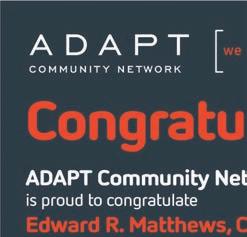
Dalio Center for Health Justice, NewYork-Presbyterian
At the Dalio Center for Health Justice at NewYork-Presbyterian, Executive Director Julia Iyasere leads e orts to address health disparities due to race, socioeconomic di erences, limited access to care, and other factors that disproportionately a ect the well-being of underserved communities. During the pandemic, Iyasere collaborated on the One Decision for Us vaccine campaign with the Harlem Children’s Zone and William Julius Wilson Institute. She is an assistant professor of medicine at Columbia University Irving Medical Center and a New York Academy of Medicine trustee. She was appointed to Mayor Eric Adams’ transition committee. Iyasere is a board member of the Center for Community Alternatives.























CEO, executive director
NYC Health + Hospitals/Community Care
At NYC Health + Hospitals/ Community Care, Nicole Jordan-Martin is responsible for the public health system’s division delivering services to patients at home and in their communities. e chief executive o cer and executive director manages patient growth, clinical integration, care management and nancial sustainability. Jordan-Martin facilitates mentorship for professional women; she hosted the health system’s rst leadership and mentoring panel on women in executive leadership. She supports the health and wellness of her sta by ensuring they are connected to various health care, wellness, and social and family support services. Jordan-Martin is a regular panelist on the weekly internet radio talk show, e Reset.
Chief innovation of cer Kinnos






Jason Kang is responsible for developing Kinnos’ patented colorization technology for disinfectants and collaborating with hospitals to establish a new standard of care. Inspired by their time ghting Ebola in West Africa—and after learning that less than half of high-touch hospital surfaces are adequately disinfected—the chief innovation o cer and his co-founders invented Highlight, a patented solution for colorizing disinfectants. Peer-reviewed studies show that their patented product improves compliance and quality by as much as 70%. Kang is involved in volunteering and mentoring at Columbia University, where he has been career chair for Columbia Engineering Young Alumni. He regularly speaks at schools about his experience as a young entrepreneur.
CEO, founder Zocdoc

Chief Executive O cer Oliver Kharraz strives to make Zocdoc the country’s most complete health care marketplace for nding and booking all types of care. Patients booking appointments on Zocdoc have an average wait time of one to three days; the average American patient’s wait time is 26 days. Since Kharraz founded Zocdoc in 2007, the company has had sustainable revenue growth, driven by the transition from a subscription to a transactional revenue model. Kharraz, who has helped unify a fragmented industry, is a member of the Council on Foreign Relations, a think tank specializing in U.S. foreign policy and international relations.
SVP of specialty services


AdvantageCare Physicians
At AdvantageCare Physicians, Leon E. Kurtz oversees the management of 10 specialty services across more than 30 medical o ces throughout the city and on Long Island. His patients have access to a ordable specialty care within their neighborhoods, including endoscopy units and accredited cardiology labs. Kurtz founded AdvantageCare Physicians’ “whole person” care model with the intention of melding quality care with nancial accessibility. Since becoming senior vice president, he has expanded care delivery across 11 locations in medically underserved areas and 17 locations in primary care health professional shortage areas. Kurtz is a fellow of the American College of Physicians and the American College of Gastroenterology.


SVP of business development



Bensonhurst Center for Rehabilitation
Edward Lai strives to make sure the Bensonhurst Center for Rehabiliation remains a valued health care facility. Working with marketing and concierge teams, the senior vice president of business development focuses on strategic initiatives, operations and marketing, with the goal of achieving exceptional patient care. Lai works with organizations such as the Chinese American Social Services Center to ensure that the medical needs of the Asian community are met. He chairs Neighborhood Advisory Board 11, which covers Bensonhurst and is part of the city Department of Youth and Community Development. Lai is a member of several local advisory councils.














is a health care champion whose strong leadership skills and clear vision have had an immediate, positive impact on our not-for-profit organization founded by the Four Brooklyn Ladies in 1907.
The Board of Directors, leadership team, and staff of MJHS Health System congratulate David Wagner for being named a Notable Leader in Health Care by Crain’s New York Business. Your commitment to our patients, residents, members, and staff remains true to our mission of caring for at-risk New Yorkers with compassion, dignity, and respect.
CEO New Horizon Counseling Center



At New Horizon Counseling Center, Herrick Lipton oversees business development and various programming, working to provide quality behavioral health care for the emotional well-being, independence and empowerment of individuals. The chief executive officer is invested in the development of behavioral health and substance use ser vices, including an addiction recovery program, a senior-Alzheimer’s program, developmental disability services and a day treatment program. Lipton also provides necessary care in underserved areas; he launched the New Horizon Food Pantry to help Long Island’s food insecure and opened the New Horizon Crisis Center as a 24-hour resource. In addition, he mentors high school students.
Founder, president and CEO Coalition of Asian-American Independent Practices Association

George Liu has been serving New York’s Asian-American communities for decades through the Coalition of Asian-American Independent Practices Association, which he founded.

Throughout the pandemic, the association filled critical health care gaps in the Asian community by implementing mobile testing, donating personal protective equipment to hospitals and nursing homes, delivering meals to essential workers and working with the state government to provide Covid-19 vaccines for Asian-American communities. Under Liu’s leadership as its president and chief executive officer, the association has more than 500,000 patients under its care. Liu has established a food pantry and mobile eye clinics, and he hosts public health education chats.


AJ Loiacono leads Capital Rx, a company dedicated to addressing supply-chain and infrastructure issues to help improve the drug pricing system. His company innovated a single-ledger model that aligns drug prices with average actual pharmacy drug costs, instead of manufacturer list prices—a pricing framework that offers claim-level accountability for prescription drug pricing. The chief executive officer is a serial entrepreneur with more than two decades of experience in pharmacy benefits and software development. Loiacono is on the board of Pioneer Mind, which connects startup founders and executives with mental health performance coaches.

President
Mount Sinai Brooklyn
At Mount Sinai Brooklyn, President Scott Lorin plays an integral role in the development and growth of needed health care services for Brooklyn residents. Lorin developed the rapid response team for the department of medicine, and he has led the Stop Sepsis Program. Under his leadership, sepsis mortality decreased by nearly 50% in two years. Lorin launched an ambulatory infusion center and pharmacy and clinical programs, such as thoracic surgery, critical care, and interventional radiology. Lorin is board certified in internal medicine, pulmonary medicine and critical care medicine.
Director of policy for the tuberculosis executive office

City Department of Health and Mental Hygiene

Michelle Macaraig supported the city Department of Health and Mental Hygiene’s Covid-19 vaccination campaign by overseeing the operation of more than 30 Covid clinics and more than 90 pop-up vaccination events. As director of policy, planning and administration for the health department’s tuberculosis executive office, she has contracted and subcontracted with community vaccinators, independent pharmacies, federally qualified health centers and hospitals to help build their vaccination capacity. Macaraig is an adjunct professor at the Rutgers University School of Public Health and a member and former survey chair of the National Tuberculosis Controllers Association.

On behalf of Robert S. Sterling, Chairman, Board of Trustees, and the Parker Jewish Institute for Health Care and Rehabilitation, we are proud to recognize
MICHAEL N. ROSENBLUT President and Chief Executive Officer, and Chairman, AgeWell New York,
 Notables in Healthcare
Notables in Healthcare
Regional president for the Northeast
Humana
At Humana, Julie Mascari is charged with strategic growth, clinical operations, network expansion, provider engagement, risk adjustment and product development. The company’s regional president for the Northeast has focused on New York, which has one of the largest Medicare-eligible and dual-eligible populations in the country. Since 2020, Mascari’s efforts have helped to double Humana’s membership in the state to more than 125,000 members. She has led provider and hospital contract negotiations and expanded operations into 16 counties in the state. Mascari is an adjunct professor at the Rutgers University School of Pharmacy and at Seton Hall’s School of Medicine.


Associate director, research and operations administration
Weill Cornell Medicine
Weill Cornell Medicine’s Sara Mathew leads all operational, regulatory and strategic aspects for the only American College of Surgeons-verified level 1 adult and pediatric trauma center and American Burn Association-verified burn center in the city. The associate director for research and operations administration also leads the entire portfolio for research, clinical trials and National Institutes of Health grants for the Department of Surgery. Mathew is the board director of Bridging Access to Care, a Brooklyn-based, community-based center providing prevention, mental health services and housing to underserved populations. In that role she has helped create strategic partnerships with the city’s health systems, schools and veteran organizations.
CEO
Adapt Community Network
At the not-for-profit Adapt Community Network, CEO Edward Matthews leads efforts to promote the organization’s mission and vision of the organization, which encompasses adult education centers, residential homes, health care clinics, family support services and assistive technology centers. In the past 18 months, Matthews expanded Adapt’s footprint of care by creating Adapt of Hudson Valley. He is a member of the Medicaid redesign task force for New York state and chair of Partnerships for Healthcare Solutions, the parent company for Partners Health Plan, which provides person-centered health plans to support adults with intellectual and developmental disabilities.
Executive director, Family Health Centers at NYU Langone
NYU Langone Health
At NYU Langone, Larry McReynolds leads one of the state’s largest federally qualified health centers, which provides care to more than 100,000 patients in underserved communities through more than 600,000 visits annually. The Family Health Centers, of which he is the executive director, serve the city’s largest Medicaid population, providing access to care for patients facing economic and tech barriers. McReynolds has guided an organization that functions as a health lifeline for some of the city’s most at-risk individuals. In 2022 the FHC served more than 7,000 homeless patients throughout the city, focusing on primary, dental, women’s and pediatric care and chronic illnesses.
President Medical Society of the State of New York
Parag Mehta is the first president of Asian descent to govern the Medical Society of the State of New York. In addition, Mehta is the chief medical information officer at NewYork Presbyterian Brooklyn Methodist Hospital. Committed to patient care and quality, he has marshaled a collaborative team approach to care, working with physician assistants, nurse practitioners and other health care professionals to provide the best care for patients. He has worked with elected officials on collective bargaining and on the veto of the Grieving Families Bill. Mehta is the past president and past chair of the board of trustees for the Medical Society of the County of Kings.
A healthcare executive with over 20 years of experience, Leonard Achan, RN, MA, ANP, brings a wealth of knowledge to his current role as LiveOnNY’s President and CEO. Working with over 100 hospitals to help save lives through organ and tissue donation, Achan oversees the federally designated organ procurement organization (OPO) for the greater NYC area. He and his team broke both city and state records for lives saved through donation with a 30% increase in organs transplanted and a 28% increase in tissue donation in 2022. Achan is also committed to reducing disparities within the healthcare industry — hiring a diverse leadership team and endowing scholarships at Adelphi University and Healthcare Leaders of New York that focus on addressing this issue. Achan also co-founded Quality Reviews Inc., a digital health company helping to empower patients. Crain’s Content Studio connected with him to discuss his impactful initiatives.




With 20+ years of leadership experience, what inspired you to get involved with organ and tissue donation?
Understanding the value of donation was not a focus in the community I was born in, raised and love — NYC. I came to realize that the focus was on the recipient, and the transplant part of the process, and rarely on the donor who freely gives the gift of life to those in need. I was a part of the problem being a son of this community we love and wanted to change it, first in NY and then across the nation.
You’ve broken city and state records for lives saved from donations. How were you able to increase awareness about the potential to save lives?
Donation is now our fundamental and primary focus, community engagement leads our strategic plan. We’re working with New Yorkers and community leaders to increase community engagement and awareness — focusing on human rights, patient rights and donor rights to laws that promote and protect donation.
What’s the biggest hurdle you’ve faced to increase donations?
The impact of not having a best in practice New York State donor registry for the NY Metro region. If we want to proportionately increase transplantation to reflect the generosity of our NY communities, we must obligate the New York State Registry with performance metrics. For example, donor registration for states that are contiguous with NY are up to 60% greater than that which we experience here in the NY Metro region. Holding state appointed donor registration contractors accountable is required. When NY taxpayers understand who is accountable for donor registration, donation will increase exponentially. New Yorkers are generous of spirit. When we know how to help, we rise. Donors are everything. Without their grace and understanding, we have nothing.
What is the biggest misconception about organ and tissue donation?
One of the biggest misconceptions is believing your religion or culture may forbid donation. We are a diverse community and know that donation
for the purpose of saving a life is the greatest human act a person can do for another. We work within every community and with cultural and religious leaders. We have no experience with any religious denomination or ritual obligation that impedes the effort to save a life. None. What can help to combat disparities within the organ and transplantation industry?
OPO’s must review their minority census population to develop an approach that supports an equitable foundation of the communities they serve. Then look at the entire donation and transplantation ecosystem in the same way. Behaviors must support a fundamental commitment, across a wide ecosystem of independent persons, to an equitable doctrine of donation and transplantation. Regulations for all parties must align with an equitability doctrine that must inform policies of inclusion, which in word and spirit will reduce disparities. LiveOnNY has direct experience with these matters and is prepared to provide witness to them.
BROOKE MONTES
Alliance for Positive Change
Brooke Montes oversees all policy work, advocacy e orts, internal and external communications, branding and marketing at the Alliance for Positive Change. As director of administration, Montes drives the organization’s mission by supporting the e orts of the executive team and board with advocacy, business administration, communications, project management and program oversight. She designed and grew a pharmacy access and treatment adherence program that helps more than 1,000 New Yorkers living with HIV adhere to their medication. Montes meets with legislators and speaks out to ensure continued access to such services for under-resourced communities.
ALAN J. MURRAY



Alan J. Murray of Empire BlueCross BlueShield works to better the experience of diverse populations in New York, championing a ordable health care policy, partnering with organized labor to enhance bene ts, and leveraging data integration to improve the way New Yorkers experience the health care system. e health insurer’s president oversees sales, provider relations, operations, planning, nance, governance, government and community relations, cost of care, and underwriting. Since the opening of Empire’s Midtown o ce, Murray and his team have used the space to support New York communities, hosting events to bene t organizations including Breaking Ground and Food Bank For New York City. Murray is on the board of Stomp Out Bullying.
Teladoc Health
For Teladoc Health, a virtual care platform, Mala Murthy manages accounting, nancial planning and investor relations, analyzes data, and crafts budgets with department heads. Teladoc’s chief nancial o cer has supported substantial acquisitions and overseen the development of capital structure and liquidity strategies. Murthy’s investment strategy focuses on expanding opportunities with clients, from Fortune 500 companies to hospitals and health systems. She is on the board of Avantor, a leading global provider of mission-critical products and services for customers in the biopharma, health care, education, government, advanced technologies and applied materials industries.

KRISTIN MYERS
Mount Sinai Health System
Kristin Myers wears several hats at Mount Sinai Health System. Myers is executive vice president, chief digital and information o cer, and dean for digital and information technology. In the past year she has begun executing a digital transformation road map to enable a seamless and equitable patient journey, with the goals of reducing physician burnout and improving clinical outcomes. Myers continued enterprise cloud migration, matured the cybersecurity program, and expanded arti cial intelligence and robotic process automation capabilities. She is on the executive diversity leadership board, and she is the corporate leader for an anti-racist road map program. Myers is on the advisory board for health at the Aurora Forge AI-accelerator.


PATRICK O’SHAUGHNESSY
Catholic Health
With more than 20 years’ experience in strategy, innovation and operations, Patrick O’Shaughnessy leads the Catholic Health health care system as its president and chief executive o cer. Earlier, O’Shaughnessy was the system’s executive vice president, chief medical o cer and chief clinical o cer. Under his leadership, Catholic Health executed an expansion plan and extended its ability to reach patients by leveraging secure telehealth technologies and partnerships for enhanced care access. O’Shaughnessy launched a plan that o ers preventive care and wellness and uses advanced primary care to identify disease earlier. He is on the Long Island Regional Economic Development Council.
for being named to Crain’s New York Business’ 2023
Leaders in Health Care. Abdou




President,
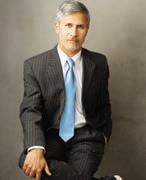
Philip Ozuah leads Montefiore Medicine, the umbrella organization for Montefiore Health System and the Albert Einstein College of Medicine. In 2022 that medical school earned more than $202 million in funding from the National Institutes of Health, and the Children’s Hospital at Montefiore was ranked by U.S. News & World Report as one of the country’s top pediatric hospitals. As the organization’s president and CEO, Ozuah focuses his efforts on building a health care system that addresses educational gaps and underlying socioeconomic factors affecting overall well-being. He is on the board of trustees for the New York Academy of Medicine, a champion of health equity.
Hip and knee surgeon Hospital for Special Surgery
At the Hospital for Special Surgery, hip and knee surgeon Michael Parks specializes in the treatment of adults with arthritis who require reconstructive procedures.
Parks is involved in clinical research, focusing on joint replacement surgery and the effects of race, ethnicity and gender on the care of arthritis patients. While addressing patients’ concerns, he works to understand how factors such as patient health care literacy, social determinants of health, and location can affect care.
Parks is treasurer of the board of directors of the American Academy of Orthopaedic Surgeons. He has collaborated with Nth Dimensions, which provides mentorship for women and underrepresented minority students interested in orthopedic surgery.

Chief scientific officer
Thorne HealthTech
Thorne HealthTech’s Nathan Price is dedicated to making prevention—and not treatment— the next frontier in health care, delivering science-based solutions that make a difference in human health. To that end, the company’s chief scientific officer partners with relevant entities to transform the way health care is practiced and charted, shifting to a wellness-centric paradigm and moving away from chronic disease management toward prevention and healthy longevity. Price, who has published nearly 20 peer-reviewed publications in collaboration with other authors, has been on the board of directors of the nonprofit Health and Environmental Sciences Institute since 2018. He has co-led the Hood-Price Integrated Lab for Systems Biomedicine since 2017.
Kenneth Raske leads the Greater New York Hospital Association, which represents several hundred not-for-profit hospitals, health systems and continuing care facilities in New York, New Jersey, Connecticut and Rhode Island. The association has played a role in opposing cuts in health care funding and in advocating legislation that protects funding for both teaching and safety net hospitals. Under the president and chief executive officer’s leadership, the association has developed expertise in government affairs, health finance, managed care, long-term care, emergency preparedness, and numerous legal, regulatory and professional affairs. Raske created the Health Economics and Outcomes Research Institute, which analyzes and interprets fiscal data and economic trends affecting health care providers.
In 2022 Kevin Reiter was promoted to deputy medical director of Northwell Health-GoHealth Urgent Care, a role in which he helps oversee clinical operations for 56 centers across New York. Reiter launched a graduate medical education program with Northwell Health for family medicine residents, physician assistants and nurse practitioner students; the program allows them to rotate in Northwell Health-GoHealth centers and gives them exposure to urgent care medicine. Noticing the shortage of X-ray technologists in the industry, he created and formalized a physician X-ray training program. Reiter works with growth and community teams at Northwell as they form partnerships with local colleges and businesses, and he gives talks on timely health care topics.

You’ve played a critical role in highlighting the importance of behavioral health. How were you able to ensure both physical and mental health were addressed in tandem?
As Chief Medical Officer at MetroPlusHealth, Dr. Sanjiv Shah brings 23 years of experience as a physician leader, managed care executive and infectious disease specialist. Over the course of his career, Dr. Shah has used his deep understanding of behavioral health to shed light on the importance of investigating both mental and physical health. He and his team have worked to expand accessibility within the industry as well as to give back to the community. Dr. Shah also played a crucial role throughout the pandemic — sharing best policies and practices in Covid-19 prevention — and was one of 24 physicians recognized at NYC Health + Hospitals’ 2022 Doctors’ Day event. Other community contributions include serving as a member for the following organizations: American Academy of HIV Medicine (NY/NJ) Chapter, HIV Medical Association, Infectious Diseases Society of America, New York Society of Infectious Diseases and Physicians Research Network. Crain’s Content Studio connected with him to discuss his inspirational career path.
My clinical background is in infectious diseases, specifically HIV care, and my patients taught me the inextricable link between mental and physical health. A long-term virally suppressed patient once shared that the mental weight of taking medications while hiding them from his relatives was at times unbearable. I always place mental health first because it always gets second billing to physical health, which underscores the importance of mental health parity.
In partnership with God’s Love We Deliver and NYC Health + Hospitals, you led a program that provided medically tailored meals to highneeds individuals. What was your inspiration for kicking off this pilot program?
Mayor Adams and Michelle McMacken, a colleague at NYC Health + Hospitals, made us rethink the importance of nutrition in the management of chronic conditions. Our medical background emphasizes prescribing medications. But my mother just turned 90 and doesn’t take chronic medications. She
attributes that to healthy eating as a lifelong vegetarian. So, when New York State instituted delivering medically tailored meals to people with chronic conditions, MetroPlusHealth committed to it. It has been a huge success.
With 23 years of medical experience, what initially led you to pursue this field?
My entry into managed care was entirely serendipitous. I was an infectious disease doctor in the Bronx and attending courses for an MPH in Epidemiology when I found an opening for a part-time Medical Director at MetroPlusHealth for its HIV Special Needs Plan. I signed on because this was a forerunner of what managed care plans rightly focus on today: care management, optimizing access, treatment adherence, removing barriers to care and addressing social determinants of health.
Throughout your work as an infectious disease specialist, what do you think is the biggest misconception about health as a whole?
I think the concept that health is a continuum isn’t always clear — it’s often viewed in the context of diseases. But diet, activity, living conditions,
social interaction and environmental exposures linked with genetics all lead to our health status. The best way to approach health is to focus on preemptive action — healthy eating and activity — no short cuts, just focusing on balance to allow the body to do what it does best. We are amazing organisms if we take care of ourselves.
As Chief Medical Officer for MetroPlusHealth, what are some goals you have in mind for the future?
Other than retirement? [laughing] The forthcoming 1115 Demonstration Waiver is going to provide a tremendous opportunity to mitigate health disparities. Various healthcare entities will collaborate and shift the balance in favor of the medically and behaviorally underserved and their families. The model of care is truly multidisciplinary — addressing patients’ medical, behavioral, social and supportive care. It’s ideal for management of all chronic medical and behavioral conditions and, if implemented, would significantly raise the health of our most challenged neighborhoods.
President
SUNY Downstate Health Sciences

University
Wayne Riley was appointed by the board of trustees of the State University of New York as the 17th president of SUNY Downstate Health Sciences University in January 2017. SUNY Downstate, among the largest employers in Brooklyn, is one of four academic health centers in the SUNY System and the only one in the city. Notably, Riley stewarded a partnership with Maimonides Health, which will allow patients at the University Hospital of Downstate to access a broader range of specialists from their cancer center. e combined program will be the most extensive hematology-oncology practice in Brooklyn. Riley chairs the New York Academy of Medicine’s board of trustees.

Vice president, chief quality of cer


Monte ore Medical Center
Michael Rinke is no stranger to Monte ore Medical Center or the Albert Einstein College of Medicine. Rinke is vice president and chief quality o cer at the former and a professor of pediatrics at the latter. Rinke and his team at the Monte ore Medical Group improved hypertension control and asthma and depression screening rates in thousands of patients across the Bronx and Southern Westchester County. He has led several national, federally funded research grants aimed at improving the health care delivery system for all patients. Rinke has spearheaded quality and safety work for more than 20 years, including national quality improvement collaboratives to reduce diagnostic errors. He is a fellow of the American Academy of Pediatrics and a member of the Society for Pediatric Research and the Academic Pediatric Association.
COO
Institute for Community Living
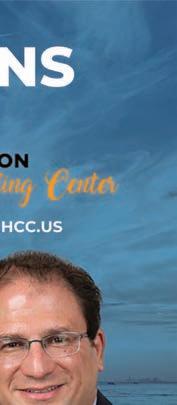
Twiggy Rodriguez oversees the operations of the Institute for Community Living, one of the city’s largest mental and behavioral health organizations. e chief operating o cer recently expanded addiction services at ICL’s East New York Health Hub, which is among the most comprehensive health care centers in the country. Rodriguez launched a program that helps the chronically homeless and places them in housing within 30 days. In addition, she led the opening of the Nevins Street Apartments, which have provided 129 accessible, supportive and a ordable housing units. Rodriguez leads ICL’s diversity, equity and inclusion work. She is a member of the National Council for Mental Wellbeing.


President, CEO

Parker Jewish Institute for Health Care and Rehabilitation
At the Parker Jewish Institute for Health Care and Rehabilitation, Michael N. Rosenblut is responsible for the overall executive leadership and strategic direction of the post-acute care organization, one of the largest in the region. Rosenblut launched Parker’s family call center, a technology-based intervention wherein patients and residents can connect with loved ones, and family members can quickly access essential information. Under the leadership of its president and chief executive o cer, Parker expanded the coverage area for Parker at Your Door, a medical house-call service that serves Brooklyn, Queens, Nassau, Su olk and Westchester. Rosenblut is the founding chairman of the board of managers for AgeWell New York.
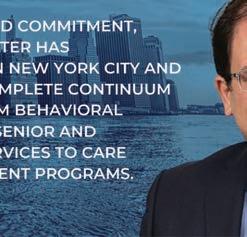

AS OF 2019, THE VAST MAJORITY OF PROFESSIONALS IN SOME HEALTH CARE ROLES (NURSE MIDWIVES, SPEECH PATHOLOGISTS, DENTAL ASSISTANTS, MEDICAL ASSISTANTS) WERE WOMEN; MORE THAN HALF OF DENTISTS, OPTOMETRISTS, PARAMEDICS, PHYSICIANS AND SURGEONS WERE MEN
U.S. CENSUS BUREAU
David Sandman guides the New York Health Foundation, a private foundation dedicated to improving the health of all New Yorkers. Since 2006, the foundation has invested more than $180 million in initiatives to improve the state’s public health system. Sandman strives to advance statewide policy changes that provide meaningful consumer protections against medical debt. Through grantmaking, policy analysis and advocacy, the foundation’s president and chief executive officer has led efforts to secure universal free school lunch for 1.1 million students enrolled in the city’s public schools. Sandman has been on the board of the Callen-Lorde Community Health Center, which provides health care and related services for New York’s LGBTQ community.




VNS Health’s Dan Savitt leads one of the nation’s largest nonprofit home and community health care organizations. Savitt helped expand VNS Health’s programs and services beyond the city and led the organization’s rebrand to simplify access to its comprehensive services. VNS Health’s president and chief executive officer led the creation of the professional solutions team and the care management organization. Under Savitt’s leadership, the organization has integrated data analytics and broadened its reputation as a national leader in the development of in-home care management solutions. In addition to many grant-based VNS Health community programs that address the needs of marginalized populations, he has contributed personally to programs focused on care for the unhoused, child development, and supportive family care.
Barbara and William Rosenthal chair of the Department of Medicine
New York Medical College
At New York Medical College, Neil Schluger focuses on public health challenges, including tuberculosis, tobacco use, air pollution and the global aspects of lung health. Schluger, the Barbara and William Rosenthal chair of the Department of Medicine at the college, is director of the East Africa Training Initiative, which he co-founded in 2013. The two-year fellowship program in pulmonary and critical care medicine is the first training program of its kind in Ethiopia and the broader East African region. Schluger was a principal investigator in the Tuberculosis Trials Consortium, an international collaboration sponsored by the Centers for Disease Control and Prevention.
Chief medical officer
MetroPlusHealth
During his tenure as chief medical officer for the insurance company MetroPlusHealth, Sanjiv Shah has led efforts to bring behavioral health services in-house so that both mental and physical health are prioritized. Shah also led a pilot program in partnership with God’s Love We Deliver and NYC Health + Hospitals to provide medically tailored meals for high-needs individuals. He led his team in expanding free access to dietitians for city workers and their families. Shah is a board member of the New York-New Jersey chapter of the American Academy of HIV Medicine and of the Physicians’ Research Network.
Chief medical officer

New York Proton Center
Charles B. Simone II provides critical leadership at the New York Proton Center for all aspects of the proton radiation therapy facility. The chief medical officer treats one of the most complex patient populations in the nation, delivering specialized protons to help patients without other curative options. Simone’s recent accomplishments include guiding initiatives to improve Veterans Health Administration cancer care, leading lung cancer practice guidelines for both the American Society of Clinical Oncology and the American Society for Radiation Oncology, and publishing the first Flash radiotherapy clinical trial. He was appointed radiation oncology vice chair of NRG Oncology, a large oncology research group. Simone is president of the Proton Collaborative Group’s board of directors.
What are the most exciting areas of lymphoma research now, and how are new developments impacting the work you do?
As CEO of the Lymphoma Research Foundation, the nation’s largest nonpro t devoted to funding lymphoma research and education since 2014, Meghan Gutierrez is the glue between cancer patients, healthcare providers, manufacturers, and scientists. She engages these core stakeholders in the foundation’s scienti c programs, including representatives from academia, government, and the business sectors, to spark new ideas that address the most pressing issues in oncology. In her role, she spearheaded the country’s only Adolescent and Young Adult lymphoma Initiative and the Lymphoma Scienti c Research Mentoring Program.
To make sure patients had continuity of care during the pandemic, she coordinated a national panel dedicated to understanding how Covid-19 was affecting people with lymphoma. She taps her experience as a former Congressional staff member for a member of the House of Representatives who was a leader in healthcare policy and as a past communications advisor for Columbia University and Partnership for a Drug-Free America. Crain’s Content Studio spoke with her recently.
The development of more effective and less toxic therapies is an exciting and important area. Our investment in cancer research has resulted in several such advancements for people with lymphoma. One is the development of several types of immunotherapy, in which the power of a patient’s own immune system is harnessed to attack cancer cells. CAR T cell therapy, checkpoint inhibitors, monoclonal antibodies, and bispeci c antibodies are all immunotherapies making a dramatic impact in the treatment and care of people with lymphoma. Another exciting area is supporting the next generation of lymphoma scientists. We feel it is critical to support early career investigators through research grants and mentoring to ensure that the brightest minds in oncology can purse novel research projects and careers in lymphoma research.
How does lymphoma research bene t other cancer types?

Lymphoma is the most common type of blood cancer, but it is a very diverse disease state, with nearly 100 different sub-types of lymphoma.
Developing new therapies to treat lymphoma is thus highly complex and focuses on highly targeted, precision approaches. Many discoveries initially made in our eld lend themselves to the treatment of other cancers. Several of the targeted immunotherapies we just discussed show great promise for multiple types of cancer. Some in our community actually refer to lymphoma as the “Rosetta Stone” of cancer research.
How do you envision technology changing the future for lymphoma patients?
Technology is transforming the way we study and develop new therapies. Machine learning and arti cial intelligence are being used to analyze clinical trial data and health records, and even to explore populationbased data to better understand the impact and trajectory of various cancers. New platforms used in the clinic, such as those that monitor minimal residual disease, have the potential to transform lymphoma care. Outside of the laboratory or clinic, tools such as telehealth and mobile health technology are empowering patients and ensuring that everyone can access quality cancer care. The Lymphoma Research Foundation has led the way in mobile health
technology since the launch of its rst-of-its-kind mobile app, Focus on Lymphoma, in 2013. The award-winning app helps patients and caregivers better understand the disease and manage their treatment.
What else would you like people to know about the Lymphoma Research Foundation?
LRF’s mission— to eradicate lymphoma and serve those touched by this disease—re ects our belief that research is critical to improving the lives of the patients, survivors, and caregivers impacted by a lymphoma diagnosis. LRF (lymphoma.org) recognizes that service to our community is equally important. We seek to meet every patient’s needs through education developed by our expert scienti c advisors as well as our free Helpline that administers nancial aid, a nationwide peer support program, and other support services. The generous people and companies who share this belief and seek to improve the lives of the entire lymphoma community make our work possible.
Chairman of the board
Somos Community Care
As chairman of the board, Ramon Tallaj leads Somos Community Care, a network of more than 3,000 doctors caring for more than 1.3 million patients. Prioritizing efforts to drive up outcomes while driving down costs via a value-based payment system, Tallaj has led a health care model that provides care for vulnerable Americans. He led Somos’ pandemic response, in which the organization provided free testing, meals and vaccines to 1.5 million people. Tallaj co-chaired Mayor Eric Adams’ Covid recovery roundtable and health equity task force. Tallaj originally moved to the U.S. to provide medical care to the Hispanic community, at the request of the cardinal of the Archdiocese of New York.
SVP and chief medical officer, Hackensack University Medical Center
Chief medical officer, North region, Hackensack Meridian Health
Hackensack Meridian Health
Lisa Tank ensures patient-centered, evidence-based care as senior vice president and chief medical officer of Hackensack University Medical Center and chief medical officer of the North region for Hackensack Meridian Health. Tank has built a robust department of medical affairs. Under her leadership, the academic medical center offers residencies in several areas of specialty, conducts extensive research and engages in numerous clinical trials. Tank, who is on the board of the Visiting Health Services of New Jersey, is an associate professor at the Hackensack Meridian School of Medicine.

Associate dean for diversity and cultural affairs
Columbia University School of Nursing
Vivian Taylor champions
Columbia University School of Nursing’s emphasis on social justice and health equity, guiding the school’s faculty staff and students toward greater appreciation of the principles of diversity, equity and inclusion. The associate dean of diversity and cultural affairs led the addition of a social justice and health equity assessment in the annual faculty and staff review process. In addition, Taylor has developed workshops, films and discussion events aimed at advancing DEI awareness. She is an active member of her community who is a choir director at St. Charles Borromeo and a commissioner and mentor with the Office of Black Ministry.

Chairman, Milton and Carroll Petrie Department of Urology Icahn School of Medicine at Mount Sinai


Ashutosh “Ash” Tewari, a proven a leader in robotic surgery, has been involved in the development of robotic prostatectomy since its inception. At the Icahn School of Medicine at Mount Sinai, Tewari chairs the Milton and Carroll Petrie Department of Urology. He was president of the Society of Urologic Robotic Surgeons from 2020 to 2022, and this year he was appointed surgeon-inchief of The Tisch Cancer Institute, a cancer facility at Mount Sinai. Tewari has received three major National Institutes of Health federal research awards. He is a member of the American Urological Association.
President
Catholic Health Physician Partners

Avni Thakore has developed and implemented plans that align with Catholic Health Physician Partners’ mission of ensuring operational efficiency and quality health care. Taking a multifaceted approach to effecting change, Thakore is implementing a flexible work environment to recruit and retain young women emerging from medical school, providing them with opportunities to both advance their careers and build families. The medical group’s president has driven its digital transformation, helping to provide equitable access to quality care. She has been invited to participate on the board of directors and executive leadership team of the American Heart Association of Long Island.



President, CEO of the Feinstein Institutes for Medical Research
Northwell Health
Kevin J. Tracey of the Feinstein Institutes for Medical Research studies how the brain and the immune system communicate via the vagus nerve with the goal of developing therapies for inflammatory diseases, such as rheumatoid arthritis, inflammatory bowel disease and cancer. Along with his colleagues, the president and CEO founded the Institute of Bioelectronic Medicine at the Feinstein Institutes, bringing together neuroscientists, immunologists and biomedical engineers. He has secured more than 120 U.S. patents and been the author of more than 400 scientific publications. Tracey, co-founder of the Global Sepsis Alliance, lectures around the world on inflammation, sepsis, the neuroscience of immunity, and bioelectronic medicine
President, CEO
Bergen New Bridge Medical Center
Deborah Visconi has expandedthe reach of the Bergen New Bridge Medical Center by opening satellite locations and primary care offices. As the center’s president and chief executive officer, Visconi has been behind the creation of an eating disorder center, launched a 3D mammography program, renovated the ambulatory surgery center and expanded the surgical procedures. Under her leadership, the center has expanded equitable access to mental health care, addiction treatment and counseling services, especially for children and adolescents. Visconi is a board member of the New Jersey Hospital Association and the president of the Northvale (New Jersey) Board of Health in New Jersey.
Chief medical officer Project Renewal Miranda von Dornum is responsible for leading Project Renewal’s federally funded nonprofit health clinics, which serve medically underserved populations in the, regardless of ability to pay.

The chief medical officer has implemented initiatives focused on improving clinical care, including tracking outcomes. She oversees the operation of five shelter-based clinics, four mobile clinics, a mobile mammography program, an outpatient and residential substance use treatment program, and a psychiatry program. Von Dornum, a longtime member of the American College of Physicians, has written several op-eds advocating health care for the homeless and other clinical solutions.

How did you get interested in healthcare?
Sara Mathew believes that access to affordable healthcare is a basic human right and has made it her mission to deliver it. She is an Associate Director of Research and Operations Administration within the Department of Surgery, overseeing the Level 1 Adult and Pediatric Trauma Center and The William Randolph Hearst Burn Center at NewYorkPresbyterian/Weill Cornell Medical Center, both of which are verified by the American College of Surgeons and the American Burn Association. In March 2023, she received the 40 under 40 Leaders in Minority Health award.
Mathew’s commitment to inclusion extends beyond the walls of the hospital. She is also a member of the board of directors for Bridging Access to Care (BAC), a New York City based community behavioral health center that works with underserved minority communities. In that role, she oversees BAC’s program and finance committee. She taps an international perspective.
Mathew earned an undergraduate degree in engineering from the University of Mumbai and a master’s degree in Healthcare Administration from the University of Minnesota, where she serves on the Diversity, Equity & Inclusion committee.

President and chief executive officer
MJHS Health System
David Wagner, president and chief executive officer of MJHS Health System, has addressed critical staffing shortages and reduced Medicare and Medicaid reimbursement levels while remaining true to the organization’s mission of caring for at-risk New Yorkers with compassion, dignity and respect. The president and chief executive officer has taken part in Department of Health work groups and subcommittee meetings on methodological reimbursement changes that affect skilled nursing facilities and managed long-term care organizations. Wagner is a member of American Institute of Certified Public Accountants and a board member of the Healthcare Association of New York State.
My mother was my introduction and inspiration to choose healthcare as my profession.She is a nurse by training and worked in hospital administration. She was passionate about helping people and her role gave her immense satisfaction despite the long and unpredictable hours. I remember shadowing her at work and got to experience firsthand what a hospital looked like, how it functioned and how she fulfilled her passion daily through her work. These moments from my childhood shaped my desire to become a leader in healthcare.
You’ve also been on the front lines of bridging health disparities for people of color. What do you see as the key challenges in New York City?
And what initiatives are you currently involved in to close the gaps?
NYC has an extraordinarily diverse population spread across all its boroughs. Within these boroughs, inequalities exist in healthcare infrastructure. This has particularly affected people of color and other vulnerable communities and created barriers to access to quality healthcare, especially mental health
services.We need systems in place to ensure all New Yorkers can receive timely access to behavioral health care. This was my motivation to join the BAC, which provides mental and preventative services to under-served communities. During my tenure, I have facilitated multiple referral relationships for BAC with hospital systems and have solidified workforce alliances with social service agencies to address their staffing shortages. These partnerships are the steppingstones towards creating a truly integrated and equitable healthcare system in NYC.
What unexpected lessons did you learn from the pandemic, now that we’re emerging from it?
Telehealth visits, which flourished during the pandemic, allowed hospitals to continue to provide care. However, as we started implementing it,we were hit with the harsh reality of the digital divide that exists in NYC. It surprised me that there were people living in the city with no internet access or devices that would enable video calling. We, as providers of care, must continue to engage with the government and federally qualified community centers to identify barriers and come up with solutions to ensure healthcare reaches everyone.
Many new technologies are changing healthcare and helping to address talent shortages. Which ones excite you most?
I am very excited about the proliferation of AI in healthcare. AI has the potential to streamline processes and aid in faster decision making for the clinicians. However, these tools cannot replace the clinicians. Hospitals need to continue to address and remedy the factors that are causing the shortages, make workforce health a part of organizational strategy and reimagine care-delivery models to curb burnout and reduce turnover.
How are you helping the next gen of healthcare leaders? What guidance would you have for others starting their journey?
I am involved with American College of Healthcare Executives, where I coach graduate students in healthcare administration and early to midcareerists through interview techniques, resume reviews and various pathways in hospital management. My advice to all upcoming healthcare leaders is to always be curious and find opportunities to participate in grassroots level initiatives which will help them keep a finger on the pulse of the community they serve.
Healthcare leader shares her journey, the future of AI and advocating for health equity
BELLEVUE, FOUNDED IN THE 1730S, IS THE OLDEST PUBLIC HOSPITAL IN THE U.S.

CEO
Mount Vernon Neighborhood Health Center
Judith Watson of the Mount Vernon Neighborhood Health Center oversees the operation of eight sites, ensuring that high quality health care is accessible to all in need regardless of ability to pay.

During the pandemic, the center operated the only walk-through testing center in the area, which was later expanded into a vaccination site. e chief executive o cer’s other accomplishments include setting up the rst mpox vaccination program in Westchester County and holding a state-funded listening program on the long-term physical and emotional e ects of Covid-19. Waton is on the board of directors of Westchester Medical Center.
IMA Group
Mark Weinberger oversees the strategic direction, expansion and day-to-day operations of the IMA Group. As the health care services company’s president and chief executive o cer, Weinberger focuses on growth. He has secured 15 acquisitions in the past four years, and he has expanded IMA’s service o erings to underrepresented individuals. Weinberger changed the way his organization conducts medical evaluations by pivoting to telehealth exams during the pandemic, leveraging information technology systems, and using e cient operating processes to reduce the friction that can exist in health care. He is a police surgeon in Elmsford, Westchester County.

National medical director

Galileo
At Galileo, a primary care group in the city, Daniel Weisberg oversees the home and community-based care model, which serves marginalized populations. In the past 18 months, the national medical director and his team have opened two markets and launched partnerships with four additional insurance payers, almost doubling patient access to the program. Weisberg’s work harnesses risk-based payment mechanisms and complex care model designs to tackle inequity in health outcomes and rising health care costs. He is a board member of the Fellowships at Auschwitz for the Study of Professional Ethics. Weisberg has produced a podcast series with the New England Journal of Medicine.
Executive vice president, chief nursing executive
Northwell Health


Maureen White is responsible for developing and implementing Northwell Health’s overall nursing policies and protocols. Besides being executive vice president and chief nursing director, White is director of Northwell’s Institute for Nursing. She focuses on advancing nursing through the melding of education, research and practice. White has implemented policies to help with the recruitment and retention of nurses, and she oversaw Northwell’s dispatching of nurses to parts of the country where surging Covid-19 cases caused hospital sta ng shortages. White was inducted as a fellow of the American Academy of Nursing. She has received the American Organization of Nurse Executives mentorship award.

NEW YORK STATE’S MEDICAID SPENDING INCREASED BY $5.2 BILLION, OR 22.9%, IN FISCAL 2021-22
OFFICE OF THE NEW YORK STATE COMPTROLLER

Senior director of administrative services, student health center New York University
At New York University’s student health center, Christopher Wong oversees a portfolio that includes operations, finance, clinical informatics and information technology. The senior director of administrative services has guided the division in enhancing service delivery and increasing collaboration with stakeholders. Wong is on the global inclusion, diversity, belonging, equity and access advisory board. He has contributed to the development of the student health center’s strategic and implementation plan. In addition, Wong plays a formative role in its business continuity plan and administrative policies. He is a fellow of both the American College of Healthcare Executives and the New York Academy of Medicine.
Chief medical officer Sword Health
Vijay Yanamadala is a neurosurgeon specializing in complex spinal conditions in addition to being Sword Health’s chief medical officer.

Under his leadership, the global digital care company published multiple clinical studies showcasing how advances in digital health can improve access to high quality care and reduce inequalities. In the past year Yanamadala was featured on National Public Radio and was named a North American Spine Society “20 under 40” provider. He is a member of the American Association of Neurological Surgeons. Yanamadala has traveled to India, Sri Lanka, Kenya and Mongolia to provide free care to underserved communities and collaborate with local surgeons to help expand their skill sets.
President, labor and chief sales and marketing officer
Brighton Health Plan Solutions
Michelle Zettergren boasts more than 25 years’ experience in the health insurance industry in various executive leadership roles in sales, product, marketing and underwriting. As president of labor and chief sales and marketing officer at Brighton Health Plan Solutions, a health care enablement company, Zettergren has led efforts to expand the company’s services for labor, commercial and health system clients, including introducing new health, trust and pension administration capabilities powered by market-leading technology. She has been named to City & State New York’s “Labor Power 100” list four years running, Zettergren is on the board of directors of the United Way of Long Island.

Chief strategy officer

Thorne HealthTech
Bodi Zhang manages Thorne HealthTech’s day-to-day execution and strategic planning across the U.S., China and Singapore. In the past 18 months the chief strategy officer navigated longstanding economic barriers to bringing Thorne HealthTech to China. Zhang helped launch the company’s TikTok store, where, shortly thereafter, one of its products was ranked among the platform’s bestselling. Zhang has 15 years of basic and clinical development experience, specializing in skin health, allergy and immunology and drug development. He has published 20 scientific papers and frequently volunteers with Committee 100, a network of Chinese business and scientific leaders promoting Asian and Chinese culture and impact.
Physician-scientist

permissible reason.
“I would say that real estate lined up in support of the housing compact and put some energy into it but not compared to the energy they put into trying to kill good cause,” said Assemblyman Harvey Epstein, who supports the measure. “ ey talk about how important 421-a is or other programs are, but actions speak louder than words.”
e version of good cause that has been proposed in New York would basically prevent a landlord from evicting a tenant without a good reason, such as non-payment of rent, being a nuisance to other tenants or using their apartment for illegal activity. Landlords could also evict their tenants if they wanted to use the space as their own primary residence. e bill also would limit rent increases to no more than 3% of the previous rent or 1.5 times the annual percentage change in the consumer price index, whichever is higher.
Landlords have long argued that
ous conversations to happen. Unfortunately, Albany is a place where that doesn’t always happen.”
Good cause rose to prominence as an issue following the 2018 elections, when Democrats achieved uni ed control in Albany following years of a power-sharing arrangement in the state Senate that gave Republicans control of the chamber. One of the rst issues they tackled was trying to strengthen the rules around rent increases on regulated apartments, part of a broader focus on tenant protections. e legislators succeeded in passing the measures they pushed for, with one major exception: good cause eviction.
“In 2019, the main thing that we were pushing for was a package of nine bills that would strengthen renters’ rights,” said Housing Justice for All Campaign Coordinator Cea Weaver, “and we won eight of them.”
But tenant advocates did not stop agitating for good cause following this defeat. Although the eviction moratorium from early 2020 to early 2022 made many aspects of the proposal moot, the issue regained its prominence last year and this year. e main reason Weaver said her organization views good cause as such a big priority is straightforward: high and rising rents.
the policy could limit the construction of new housing, harm small property owners and make it harder for owners to a ord necessary repairs. Tenant groups deny those claims, framing the issue as an essential protection and pointing to states like New Jersey, which has good cause protections and still sees robust housing growth.

Hochul never voiced support for good cause during budget talks, while legislative leaders, spurred on by more progressive members, tentatively backed it in their proposals. But hopes of a grand bargain linking tenant protections with issues like growth mandates, extending the deadline for projects in the 421-a a ordable housing program and lifting a cap on residential density in the city likely stood little chance as long as good cause opponents viewed preventing its passage as more important than getting a new tax break.
is dynamic has been at play for years now in Albany, contributing to a stalemate on many housing issues even as the state confronts a serious housing crisis. Few pieces of major housing legislation have emerged from Albany since the 2019 tenant protection laws restricting rent increases on regulated apartments, apart from pandemic-era emergency measures, and although there is hope for progress on housing during the current legislative session, whether there is a way out of the impasse remains unclear.
“For the good of property owners, for the good of renters, for the good of New York, we have to solve our housing shortage issues,” said Community Housing Improvement Program Executive Director Jay Martin, who opposes the currently proposed version of good cause. “It would require a lot of intense, seri-
“Every day I’m talking to people who are seeing 100, 200, 300% rent increases,” she said. “We’re in a really deep, deep crisis of a ordability. Good cause will slow rent increases and protect people as the market crazy gentri es, give people the rights to organize in their buildings and seek repairs without fear of retaliation. It’s just necessary.”
Tenants gained a rare amount of pricing leverage for apartments during the early months of the pandemic, leading to signi cant rent drops for the rst time in recent history, but prices have since come roaring back. Rarely a month goes by now without rents hitting a record high, and March was no exception, when median Manhattan rent hit a new peak of $4,175, according to a Douglas Elliman report.
New York’s housing shortage was the real estate issue that took center stage during budget negotiations, with many proposals from Hochul in particular focused on increasing housing production. Epstein argued that good cause needed to be part of this conversation as well to ensure that any new homes would be a ordable for New Yorkers.
“Without good cause eviction, you build 100unit buildings, and the people who move in there have no tenant protections, so they’re subject to huge rent increases. at’s impactful,” he said. “It’s not like one thing happens without the other.”
Jim Whelan, president of the Real Estate Board of New York and an outspoken opponent of good cause, took the opposite viewpoint. He stressed that the main issue facing New York is a housing shortage, which good cause would do nothing to address. It thus makes no sense to pair a debate on good cause with a debate on issues like growth mandates or o ce to residential conversions, he said.
“We have many housing issues to tackle in New York City, but clearly the rst issue is what to do about housing supply,” he said. “You’re asking me to negotiate good cause eviction, which no one claims helps supply, so why would one start there?”
Middle ground
State Sen. Brian Kavanagh, who supports good cause and chairs the housing committee, pushed back on the idea that it was single-handedly holding up negotiations over other housing issues, describing this as a “false narrative.”
“ ere were a lot of people who were opposed to the major elements of the compact who were also opposed to good cause eviction,” he said. “ ere were a lot of people who wanted one of those but not the other.”
Justin Henry, a spokesperson for Hochul’s o ce, said good cause did not play a major role in the omission of housing policies from the state budget. He instead pointed to Hochul’s admission that she pulled housing from negotiations after the Legislature refused to sign onto her growth mandates.
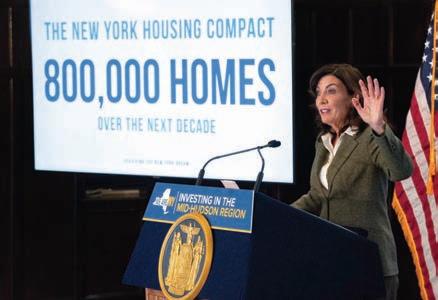
Many advocates and opponents also insisted they were willing to compromise on the polarizing issue.
Martin cited multiple issues his group has with the current proposal, including the automatic inclusion of new buildings and a lack of clarity around what happens when a tenant’s lease expires. But he stressed that this opposition was about math, not ideology, and that his group could support a version of good cause if the economics made sense.
“It’s not just ‘trade one for the other’ for the political wins that the legislature wants,” he said. “It’s what, at the end of the day, balances books.”
Weaver sounded a similar note, saying her organization was not dead-set on passing the current version of good cause or nothing at all.
“We’re really open to changes to the good cause legislation that will bring more players to the table,” she
said. “We’re open to a comprehensive housing package that includes things more on the developer-friendly side.”
She argued that opponents were more dug in than supporters, seeing good cause as a symbolic step in the wrong direction for real estate regardless of the speci cs. Developers are also much better positioned to wait out an absence of housing legislation than tenants, she said.
“An impasse for the industry is an easier thing to sustain than for the people I work with,” she said. “Our people have, unsurprisingly, less liquidity than the real estate industry.”
‘The local Housing Politburo’


Indeed, some real estate groups have framed their opposition to good cause in explicitly ideological terms. Homeowners for an A ordable New York, a coalition of 11 landlord, real estate and construction groups, formed last year with the goal of lobbying against good cause and spent this year’s budget session blasting out press releases that deride good cause supporters as “the local Housing Politburo” and “far-left socialists.”
“Eighty percent of eviction lings in New York are the result of non-payment of rent,” Greg Drilling, a spokesperson for HFAANY, said in a statement. “We urge the legislature to support the Housing Access Voucher Program and Statewide Right to Counsel, which would bring immediate and needed relief to renters. e legislature should also continue to reject socialist ideas like good cause eviction legislation, which does nothing to address non-payment of rent and would devastate New York’s future housing supply, leading to an increase in homelessness.”
But Epstein said such a hardline approach would ultimately work against the real estate industry. ey took a similar tactic in 2019, and this just led to the state passing its rent reform package with almost no input from them, he said.
“Either they’re going to be at the table saying the things that they want,” he said, “or we’re going to push it through anyway.” ■
“WE’RE IN A REALLY DEEP, DEEP CRISIS OF AFFORDABILITY”GOV. KATHY HOCHUL/FLICKR GOV. KATHY HOCHUL did not come out in support of good cause eviction as she pushed her housing growth package during state budget negotiations. STATE SEN. BRIAN KAVANAGH speaks during the May 10 rally for good cause eviction at the state Capitol.
Product Manager II positions (Turner Services, Inc.; NY, NY).
Work closely w/ business stakeholders to define product strategy related to enhancing the overall user exp to gain new subscriptions, improve retention & provide company w/ competitive advantage. Position based in NY, NY. May telecommute from anywhere in the U.S. Must be willing to travel 5% internationally & 5% domestically. Salary range is $116,002/yr - $161,000/yr, depending upon qualifications. Email resume to GMRI@warnerbros.com. Ref: 6015013PMII2.
Invitation to Prequalify and to Bid
Rehabilitation and Flood Mitigation of the New York Aquarium, Brooklyn, NY : Turner Construction Company, an EEO Employer, is currently soliciting bids for the Rehabilitation and Flood Mitigation of the New York Aquarium from subcontractors and vendors for the following bid packages:
BP #041B - Plumbing
Only bids responsive to the entire scope of work will be considered and, to be successful, bidders must be prequalified by Turner. Certified M/WBE and Small Business (13 CFR part 121) companies are encouraged to submit.
In order to receive the bid packages, potential bidders either (1) must initiate the prequalification process by submitting a Subcontractor/Vendor Prequalification Statement to Turner, or (2) must be prequalified based on a prior submission to Turner (Note: Prior prequalification submissions that remain current will be considered as previously submitted or may be updated at this time.) All bidders must be prequalified by the bid deadline: July 6th, 2023 and initial submission of a prequalification statement not later than July 6th, 2023 is strongly encouraged All bidders must have an acceptable EMR, and will be subject to government regulations such as 44 CFR and Federal Executive Order 11246. Successful bidders will be required to use LCP Tracker compliance verification software. Note that while this is a New York City prevailing wage project, union affiliation is not required for BP #041B
A Webcast about the above Bid Package/s will be held on June 8th 2023 Attendance is optional for all; the Webcast is designed to assist potential M/WBE subcontractors/vendors.
Link: Please join this meeting from your computer, tablet or smartphone. https://teams.microsoft.com/l/meetupjoin/19%3ameeting_NTVjNmZlMTctODdjNy00YWRmLWJmMmYtZjI4NzNjMzcwNWVi%40thread.v2/0?context=%7b%22Tid%22%3a%2220e277 00-b670-4553-a27c-d8e2583b3289%22%2c%22Oid%22%3a%22732a90ce-24b7-42eb-bf78-d638e2a629ac%22%7d
To obtain further information about contracting opportunities and/or the prequalification package and bid solicitation package/s, please contact Lyndsey Spangel, lspangel@tcco.com 646-842-1659.
The date for the virtual public opening at the Turner Construction Company office located at 66 Hudson Yards, New York, New York is July 7th, 2023 10 AM
Link: Please join this opening meeting from your computer, tablet or smartphone. https://teams.microsoft.com/l/meetupjoin/19%3ameeting_NThmN2MzNDctNGEzNC00MTA5LWE2NjYtZTI0ZWVjZGVmM2Nj%40thread.v2/0?context=%7b%22Tid%22 %3a%2220e27700-b670-4553-a27c-d8e2583b3289%22%2c%22Oid%22%3a%22732a90ce-24b7-42eb-bf78d638e2a629ac%22%7d
Notice of Formation of STURDY INCLINE LLC, Arts of Org filed with Secy of State of NY (SSNY) on 1/24/23/ Office Location: NY County. SSNY designated as agent upon whom process may be served and shall mail copy of process against LLC to 228 PARK AVE S, #974932 NY, NY 10003 R/A: US Corp Agents, Inc. 7014 13th Ave, #202, BK, NY 11228 Purpose: any lawful act.
Contact
Rupish Transport, LLC. Art. Of Org. filed with the SSNY on 2/8/2023. Office: New York County. SSNY designated as agent of the LLC upon whom process against it may be served. SSNY shall mail copy of process to the LLC, 769 Broadway, #1158, New York, NY 10003.
Purpose: Any lawful purpose.
NOTICE OF FORMATION of DU SEL LIMITED LIABILITY COMPANY.
Arts of Org filed with Secy. of State of NY (SSNY) on 3/17/23. Office location: NY County. SSNY designated as agent upon whom process may be served and shall mail copy of process against LLC to 99 Warren St, NY, NY 10007. R/A: US Corp Agents, Inc. 7014 13th Ave, #202, BK, NY 11228.
Purpose: any lawful act.
BRONX PRIMARY MANAGEMENT, LLC
filed Arts. of Org. with the Sect'y of State of NY (SSNY) on 2/16/2023. Office: New York County. SSNY has been designated as agent of the LLC upon whom process against it may be served and shall mail process to: c/o Julio A. Sanchez, 3421 Broadway, NY, NY 10031. Purpose: any lawful act.
912 PLYMOUTH STREET LLC.
Arts. of Org. filed with the SSNY on 11/01/22. Office: New York County. SSNY designated as agent of the LLC upon whom process against it may be served. SSNY shall mail copy of process to the LLC, 234 Bradhurst Ave 6, New York, NY 10039. Purpose: Any lawful purpose.
Notice of Formation of JOSEPH DEFRAINE GREENWELL LLC. Arts of Org filed with Secy. of State of NY (SSNY) on 2/4/23. Office Location: NY County. SSNY designated as agent upon whom process may be served and shall mail copy of process against LLC to 603 West 148th St, Apt 10B, New York NY 10031. Purpose: any lawful act.
Notice of Formation of SILVER HILL MANAGEMENT GROUP, LLC
Arts. of Org. filed with Secy. of State of NY (SSNY) on 03/14/23. Office location: NY County. Princ. office of LLC: 208 Valley Rd., New Canaan, CT 06840. SSNY designated as agent of LLC upon whom process against it may be served. SSNY shall mail process to the LLC at the addr. of its princ. office. Purpose: Any lawful activity
Notice of Formation of REED PLACE LLC. Arts of Org filed with Secy . of State of NY (SSNY) on 2/27/23. Office location: BX County. SSNY designated as agent upon whom process may be served and shall mail copy of process against LLC to 1418 Reed PL. Bronx, NY 10465.
Purpose: any lawful act
Leonard East 68 LLC-Arts. of Org. filed with Secy. of State of NY (SSNY) on 1/27/23. Office location: New York Co. SSNY designated as agent of LLC upon whom process against it may be served. SSNY shall mail process to: c/o
Steven R. Ganfer, Esq, Ganfer Shore Leeds & Zauderer LLP,360 Lexington Ave, NY, NY 10017.
Purpose: Any lawful purpose.
Notice of Formation of Bonfatti LLC. Arts of Org filed with Secy. of State of NY (SSNY) on 2/5/23. Office Location: NY County. SSNY designated as agent upon who process may be served and shall mail copy of process against LLC to 115 W 130th St. Bsmt A, NY , NY 10027. R/A: US Corp Agents, Inc. 7014 13th Ave. #202, BK, NY. Purpose.: any lawful act.
Notice of Formation of Prince Driving Schol LLC.
Arts of
Notice of formation of Immescherable Consulting LLC. Arts of Org filed with Secy. Of State of NY (SSNY) on 1/24/23. Office location: NY County. SSNY designated as agent upon whom process may be served and shall mail copy of process against LLC to 149 E 23rd St, #186, NY, NY 10159. P/B/A: 280 Park Ave S, #9M, NY, NY 10010.
Purpose: any lawful act.
Notice of Qualification of PICKS AND SHOVELS GP, LLC Appl. for Auth. filed with Secy. of State of NY (SSNY) on 04/04/23. Office location: NY County. LLC formed in Delaware (DE) on 03/10/22. Princ. office of LLC: 625 W. 57th St., Apt. 713, NY, NY 10019. SSNY designated as agent of LLC upon whom process against it may be served. SSNY shall mail process to Corporation Service Co. (CSC), 80 State St., Albany, NY 12207-2543. DE addr. of LLC: c/o CSC, 251 Little Falls Dr., Wilmington, DE 19808. Cert. of Form. filed with DE Secy. of State, 401 Federal St., #4, Dover, DE 19901.
Purpose: Any lawful activity
Notice of Qualification of VANDERBILT HEALTH CLUB LLC Appl. for Auth. filed with Secy. of State of NY (SSNY) on 04/04/23. Office location: NY County. LLC formed in Delaware (DE) on 03/28/23. SSNY designated as agent of LLC upon whom process against it may be served. SSNY shall mail process to c/o Corporation Service Co. (CSC), 80 State St., Albany, NY 12207-2543. DE addr. of LLC: c/o CSC, 251 Little Falls Rd., Wilmington, DE 19808. Cert. of Form. filed with Secy. of the State of DE, c/o The DE Dept. of State, Div. of Corps., John G. Townsend Bldg., P.O. Box 898, Dover, DE 19903. Purpose: Any lawful activity
RI Feng LLC filed w/ SSNY 4/24/23. Off. in NY Co. SSNY desig. as agt. of LLC whom process may be served & shall mail process to the LLC, 57 E. Broadway, NY, NY 10002. Any lawful purpose.
report he co-authored called “ e State of Food Halls 2023.”
“From in ation to labor and food costs, the ‘old’ model of the independent restaurant continues to force challenges,” the report noted. And vendors face similar hurdles.
“But because of the inherent model of food halls, these challenges to their sustainability are signi cantly reduced.”
From 2019 to 2023, the number of food halls nationally leaped by 55%, from 220 to 340, a trend that also played out in New York, which saw a jump of 46%, from 26 to 38, Cushman and Wake eld said. Along the same lines, only 22 closed nationally between March 2020, when the pandemic erupted, and this past winter, the report said. New York had four of them.
At the same time, 127 are planned nationally, with ve of those in the city, according to the data, a fact that comes as no surprise to some operators. “ ere’s more urgency from landlords about needing them now,” said Kerry Garber, marketing director for food hall operator Urbanspace, an

or 20-foot-by-20-foot stalls. Similarly, communal kitchens have given way to individual work spaces, brokers and operators say. ere’s also more alcohol owing today.
Operators are also providing more space in the halls, which average 15,000 square feet, for programming, whether that involves small concerts or cooking classes.
Usage patterns have changed too. Fridays used to be the busiest day, said Garber of Urbanspace, but as many Midtown employees continue to work remotely for some of the week and have Fridays o , peak eating and drinking now happens on Wednesdays.
Customer totals are hovering below 2019 levels at Urbanspace’s outposts, which include 570 Lexington Ave., 100 Pearl St. and 135 W. 50th St., where a pair of former delis last fall transformed into the Singapore-themed Urban Hawker eatery. “But our numbers are certainly moving in the right direction,” Garber says.
e locations have recently put in place some technological changes to bene t their corporate clientele. Customers can now summon dishes from multiple kiosks with just a single order, which helps executives who seek to order lunch for their whole o ce as a company perk, Garber said, adding that “they are really eager to bring some fun into the o ce.”
heir income to whomever is running the show.
Ultimately, if a landlord chooses the middleman model, it’s often at the behest of lenders, which can prefer to see a steady stream of rental income for retail spaces, according to Cushman and Wakeeld. “At the end of the day, economics usually speak the loudest,” Colicchio said.
lined space selling lobster rolls, kebabs and sushi. Several bars there were thronged with suit-wearing customers during a recent weekday happy hour.
industry leader that opened its rst location in 2015 at 230 Park Ave., an RXR Realty-owned tower, and has a total of six New York locations today, all in o ce buildings.
“O ce buildings with food and beverage options in their retail spaces are usually the ones with the highest occupancies,” Garber said.
Evolving model
New York’s food halls have evolved considerably since they rst arrived about a decade ago. e stalls have gotten smaller and now average about 400 square feet,

Local food halls today basically adhere to one of two business models, brokers say, both of which can feel more like partnerships than typical tenant-landlord arrangements.
Under one model, revenue from food sales ows directly from vendors to landlords. Under the other model, the same revenue is channeled to a middle-man operator who holds the master lease with the landlord.
Either way, vendors in New York today typically shell out $35,000 to $50,000 as a sort of entry fee, pay for the buildout of their stall and later allocate between 20% and 35% oft-
Proving a link between amenities and occupancy rates can be di cult. Similarly, some landlords are loath to talk about the special sauce they use to keep their towers lled. But there is nonetheless data to suggest a strong correlation. Consider Midtown’s 601 Lexington Ave., the angled-roof tower at East 53rd Street once known as the Citigroup Center, for instance. In 2021 owner Boston Properties renovated a 1990s mall at its base into the Hugh, a stylish food hall operated directly by the landlord itself. A bank branch, donut shop and grilled-cheese stand there for years have given way to a ceiling-lamp-
And the 59-story tower, which is co-owned with Norges Bank, is 97% leased, according to data provider CoStar, to tenants including nancial rm Blackstone, law rm Kirkland and Ellis and Citigroup, which pay annual rents of between $90 and $110 per square foot. e building is among the most-occupied of Boston Properties’ nine New York properties, public lings show. Boston Properties declined to comment.
Many of the food halls opening now were part of plans put in place years ago, such as the new Googlebacked Market 57 at Pier 57. But still, some landlords say they can use the extra marketing more than ever and are eager to tout having an in-house, ground- oor eatery for workers clocking long hours upstairs.
Zero Irving, a new o ce tower near Union Square, for example, added a 10,000-square-foot Urbanspace o ering in the winter, though it had been planned since 2015. e food hall has been somewhat slow since, which Josh Wein, a managing director for building developer RAL Cos., attributes to the weather over the past few months.
But the 13-vendor outpost, which features Greek, Mexican and Brazilian options, plus a spacious terrace, enjoys a front-and-center berth in marketing materials all the same. As of early May, Zero Irving is 96% occupied by tenants that include venture capital rm Sequoia Capital and PayPal-like startup Melio Payments, which pay between $100 and $170 per square foot annually, according to Wein.
Wein and Urbanspace declined to say what Urbanspace pays to lease the site, which is near ird Avenue, though recent asking retail rents in the neighborhood are around $400 per square foot a year, according to the brokerage CBRE.
“Having convenient places to eat lunch has always been important
for landlords and employers,” said Wein, adding that the popular cafeteria at Time Inc.’s longtime Sixth Avenue headquarters, for instance, was a selling point for hires. “ e truth is, now we’re starting to realize the additional bene ts of it.”
Foodie pioneers
Food halls are of course not limited to o ce buildings. In fact, residential versions could be seen as the pioneers. Gotham West Market, a 15,000-square-foot site on the Far West Side, opened in 2014 to o set the relative food desert encountered by tenants in the massive Gotham West apartment complex. Its developer, Gotham Organization, soon added a similar food hall at its Ashland rental development, at a commercial edge of Fort Greene, Brooklyn.
But the Gotham halls faced high turnover, which seems to have informed a decision by the company to eliminate the operators and manage the eateries itself. Generally speaking, food halls in apartment buildings can be hamstrung by having to close early, unlike in commercial buildings. O ce buildings also tend to have larger potential pools of customers, operators say, making their future as an o ce perk seem brighter.
In fact, the March closure of the 18-vendor Williamsburg Market, which came after just a few months of operation, was doomed by the fact that it was inside a North ird Street residential building and didn’t have a lot of o ce workers to attract, some former vendors say.
“We never really had a chance,” said Margaret Mieles, an owner of Midwood’s Di Fara Pizza, which had a stand at the market. “I’m probably done with food halls myself.”
Cameron Schur, a principal of the operator, Moonrise Ventures, and Waterbridge Capital, the building’s landlord, had no comment.
But advocates say the closures have merely separated some of the weaker players from the pack. “At the end of the day, we believe in these things,” Colicchio says, “and think they’re really important.” ■
“OFFICE BUILDINGS WITH FOOD AND BEVERAGE OPTIONS IN THEIR RETAIL SPACES ARE USUALLY THE ONES WITH THE HIGHEST OCCUPANCIES”BUCK ENNIS THE OUTSIDE OF the Hugh, located at 157 E. 53rd St. THE INSIDE OF the Hugh, located at 157 E. 53rd St.
